BOSTON–PropertyShark released its annual most expensive zip codes of 2021. New England is home to 11 of the priciest U.S. zip codes, including #2 with Boston’s Back Bay. The full list is included towards the end in this article.
Key Takeaways:
- At nearly $7.5 million, Atherton, Calif.’s 94027 remains #1 most expensive zip code for fifth consecutive year
- Record $5.5 million median sale price gives Boston’s 02199 #2 spot
- Top 10 most expensive zip codes in 2021 all surpass $4 million mark — a historic first
- 33109 in Miami jumps 66% Y-o-Y, becomes #5 priciest in U.S.
- Nationally, 30 zips feature median sale prices higher than $3 million, more than double the number of areas in 2020
- Country’s 100 most expensive zip codes located in 10 states, with 70% from California
- Bay Area claims 47 of nation’s most exclusive zip codes
- Los Angeles County remains priciest county with 21 entries
- Once again, San Francisco boasts highest concentration of pricey zip codes, while NYC drops out of top 20
- Gibson Island’s 97% Y-o-Y price surge claims Maryland’s highest position yet at #23
- Exclusive Lake Tahoe enclaves rule Nevada real estate, Paradise Valley returns Arizona for 3rdconsecutive year
Ranking the Priciest U.S. Zip Codes by Closed Home Sales
Even as another uniquely challenging year — marked by the efforts of tackling the pandemic and boosting the economy — is coming to an end, the U.S. residential market continues to experience vertical price trends. And, that picture is clearly visible in our 2021 edition of the 100 most expensive zip codes in the U.S. — which, for the first time ever, includes 127 zip codes due to multiple ties.
Compiled by calculating median home sale prices as opposed to listing prices to ensure an accurate picture of market conditions as opposed to selling prices that reflect sellers’ wishes, this year’s edition highlights the ever-increasingly competitive residential markets of economically vital urban centers.
The Bay Area, Los Angeles County, and New York City yet again have a heavy presence, joined by exclusive pockets of affluence scattered across the country, like Arizona’s Paradise Valley, Washington state’s Medina and Connecticut’s Fairfield County. What’s more, 2021’s competitive residential landscape is further evidenced by the country’s 10 most expensive zip codes — all of which surpassed the $4 million threshold, marking a new record.
For the full ranking of 2021’s 100 most expensive zip codes, scroll to the bottom of the page. For an even more detailed picture, explore last year’s rankings.
California Claims Overwhelming Majority of Expensive Zips Yet Again, Alongside New York & 8 Other States
 Unsurprisingly, California continued to provide the bulk of the country’s most expensive zip codes: The Golden State originated 70% of all of the zip codes on this list, including six of the top 10 priciest. And, as usual, New York came in second, providing 17 zip codes in our ranking.
Unsurprisingly, California continued to provide the bulk of the country’s most expensive zip codes: The Golden State originated 70% of all of the zip codes on this list, including six of the top 10 priciest. And, as usual, New York came in second, providing 17 zip codes in our ranking.
Notably, New York logged three fewer than last year — demonstrating California’s more vertical price trends, as well as the pricing slowdown in NYC’s top markets. In fact, while 2020 marked the first time that no NYC zips ranked among the country’s 10 most expensive, 2021 brought another historic first for the East Coast giant: No NYC zip codes ranked among the 20 priciest in the U.S. this year, with the state represented only by the Hamptons at the top of our ranking.
The East Coast made its presence further known with Massachusetts, home to seven of the top 100 zips in the U.S., up from last year’s four. Not only that, but as sales activity improved in Boston’s Back Bay area, Massachusetts claimed the #2 most expensive zip code in the country with 02199’s $5.5 million median sale price, which was only surpassed by California’s Atherton at more than $7 million.
To the south, Connecticut’s presence also improved compared to previous years: For the first time since 2018, it contributed four zips to the country’s priciest, most of which ranked in the bottom half of our list — similar to the three zips provided by New Jersey. Out west, Nevada and Washington added two zips each, with Washington state claiming #10 with Medina’s ever pricey 98039.
Additionally, Arizona, Florida and Maryland each contributed one zip code. Florida claimed the #5 most expensive zip code with Miami Beach’s 33109 — the highest-ranking for the Sunshine State since 2017. Meanwhile, New Hampshire missed the top 100 this year, having secured a presence during the last two years with Rye Beach.
Maryland Claims Sharpest Price Gain at 97%, While NYC’s Upper West Side Contracts 39%
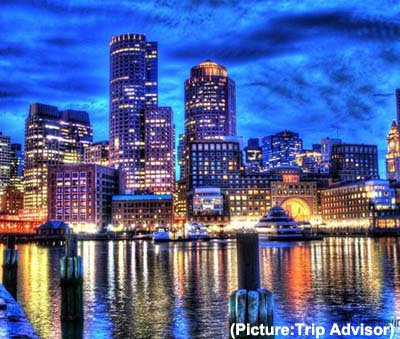 The U.S. residential market’s vertical price trends were evident among the country’s top zip codes as well, with 92 zips registering price gains — including 23 where the median surged by more than 25%. Conversely, only 12 locations among the priciest registered drops in their medians this year – by comparison, 2020 brought median increases to 78 zips and drops to 23 locations.
The U.S. residential market’s vertical price trends were evident among the country’s top zip codes as well, with 92 zips registering price gains — including 23 where the median surged by more than 25%. Conversely, only 12 locations among the priciest registered drops in their medians this year – by comparison, 2020 brought median increases to 78 zips and drops to 23 locations.
At the same time, a record 30 zip codes posted median sale prices of $3 million and above — more than double those in 2020 — with the top 10 most expensive zips coming in at $4 million and higher. Moreover, the last zip code to enter our ranking — San Francisco’s 94122 — did so with a 12% year-over-year (Y-o-Y) increase in its median sale price, managing to hold onto its #100 position from last year.
The sharpest price gain was claimed by 21056 in Maryland’s Gibson Island, which nearly doubled its median sale price, surging 97% Y-o-Y to hit $3,195,000. Gibson Island was followed by 89402 in Nevada’s Crystal Bay, which swelled 68% to reach #39 with a $2.5 million median. The third-sharpest gain was claimed by 33109 in Miami Beach, which rose 66% to a $4,475,00 median sale price to become the #5 most expensive zip code in 2021.
The sharpest price contraction was registered in NYC’s Upper West Side, where zip 10069 contracted 39% Y-o-Y to stabilize at $1,663,000. As a result, the Upper West Side zip dropped from last year’s #22 to #93 this year. Notably, this zip code was actually the leader of price growth in 2020, when its median shot up 42% Y-o-Y.
Across the country, the second-sharpest price drop was registered by 94904 in Greenbrae, Calif., which contracted 12% Y-o-Y. It was followed by Bridgehampton, N.Y.’s 11932, down 11% Y-o-Y. Located in the famously pricey Hamptons, 11932’s price contraction meant that this zip — which was the #7 most expensive in 2020 — came in at #31 this year, its lowest position in three years.
Unshakeable Atherton Maintains #1 Spot for 5th Consecutive Year, Boston Grabs #2 with Record $5.5M Median
A record-setting year for the most expensive zip codes in the U.S., the 10 priciest zip codes in the country now sport median sale prices of $4 million and above. All in all, the 10 most expensive zip codes in the U.S. were provided by five states (as opposed to last year’s three): California claimed six of the top 10 and was joined by Massachusetts, Florida and Washington, as well as New York, which was solely represented by the Hamptons.
Reaching a new record median sale price at $7,475,000, Atherton’s 94027 remains the #1 most expensive zip code in the U.S. for the fifth consecutive year — nearly $2 million ahead of the runner-up. Not only that, but the billionaire favorite also saw its median rise 7% Y-o-Y, suggesting that this exclusive enclave may continue to retain its leading position in the future.
Meanwhile, on the opposite coast, Boston’s 02199 was conspicuously absent last year due to depressed sales activity during the onset of the pandemic — despite that it historically features one of the highest median sale prices in the U.S. However, the Prudential Center area of Back Bay returned in 2021 with a $5.5 million median sale price — its highest figure yet. Consequently, Boston’s 02199 became the #2 most expensive zip code nationwide, outpacing even ultra-exclusive Hamptons enclaves.
Similarly, another well-established presence among the priciest zip codes in the country, Sagaponack’s 11962 was this year’s #3 most expensive zip code, dropping from the runner-up slot it held for three consecutive years, despite a 29% Y-o-Y price uptick that raised its median sale price from $3,875,000 to $5 million. It was also the only zip from New York state to rank in the top 10, as NYC lost further pricing ground, failing to rank a single zip among even the top 20.
In Ross, Calif., 94957 retained its previous year’s position at #4 with a $4,583,000 median sale price, the result of a 27% Y-o-Y increase. A favorite of Silicon Valley executives and celebrities, this marked the first time that Ross surpassed the $4 million pricing mark.
Conversely, Miami Beach’s 33109 may have ventured into the $4 million and over category back in 2017, but this exclusive Florida enclave reached new pricing heights in 2021: 33109 on exclusive Fisher Island stabilized at $4,475,000 to become the #5 most expensive zip code after a staggering 66% Y-o-Y price jump.
Bay Area Still the Priciest Metro with 47 of the Top U.S. Zip Codes
As has increasingly been the case in recent years, greater Los Angeles, the vast New York metropolitan area and the Bay Area remained the leading metros for pricey zip codes. In particular, the Bay Area was yet again the uncontested leader, contributing 47 zip codes to our list — including three of the top 10 zips — while the greater Los Angeles was represented by 30 Orange and L.A. County zips.
The New York metro was represented by 22 zip codes, with only six of those from NYC proper and the rest located in the Hamptons, Nassau County and Westchester, as well as Connecticut’s Fairfield County and New Jersey’s Bergen and Monmouth counties.
L.A. County Remains Most Expensive, Santa Clara & San Mateo Form Pricey Zip Supercluster
Clearly, not even the tech dollars of Silicon Valley could unseat Los Angeles County, which again was the hottest county in the country for expensive real estate with 21 of the priciest zips in the U.S. Its most expensive zip was Beverly Hills’ famed 90210, a veteran of our yearly rankings and the #6 nationally with a $4,125,000 median sale price.
Not to be outdone, the Bay Area’s Santa Clara and San Mateo counties contributed 15 and 10 zips, respectively, to our ranking as the second- and third-most expensive counties in the U.S. As a result, they form a nearly contiguous supercluster of ultra-expensive zip codes that cover high-profile tech centers such as Menlo Park, Mountain View, Palo Alto, San Jose and Sunnyvale. And, while San Mateo’s top zip was overall leader 94027 in Atherton, Santa Clara’s highest-ranking zip was 94022 in Los Altos, which landed at #9 with a $4,052,000 median sale price.
A special note goes to Santa Barbara County, which increased its presence from just one zip code in 2020 to five in 2021. Its top zip code was 93108 in Santa Barbara’s exclusive enclave of Montecito — home to the likes of Oprah and former royals Prince Harry and Meghan Markle — which claimed #7 overall with a $4,103,000 median, following a 40% Y-o-Y pricing jump.
San Francisco, Los Angeles & New York City Hold Highest Concentrations of Exclusive Zips
For the fifth year in a row, San Francisco had the highest concentration of expensive zip codes of any city, ranking seven among the top 10. It was followed by Los Angeles and NYC, with six zips each. However, while San Francisco led the way, most of its zip codes were actually in the bottom half of our ranking: Its priciest zip (94123) placed at #46 — down 10 positions compared to 2020, despite a 7% uptick in its median. Covering the iconic Marina District, 94123 featured a $2,307,000 median sale price.
Of L.A.’s six zips that ranked nationally, its top three — 90272, 90077 and 90049 — form an uninterrupted cluster of pricey real estate with medians greater than $2 million. The trio was led by Pacific Palisades’ 90272 at #21 with a $3.25 million median sale price after an 18% Y-o-Y increase. Covering Bel Air, Holmby Hills and areas of Beverly Glenn, 90077 was #42 nationally with a $2.46 million median, while Brentwood’s 90049 grabbed #52 at $2,165,000.
Back in the Empire State, NYC’s presence weakened yet again: While 2020 marked the first time ever that no NYC zip codes were among the country’s 10 most expensive, in 2021, NYC came in below the top 20, too. More precisely, its most expensive zip — 10013 — just missed out, landing at #22 with a $3,212,000 median sale price, followed by 10007 at #25 with a median of $3,125,000.
Next up, Newport Beach had the the third-highest concentration of pricey zips in a city, with five entries, followed by Santa Barbara with four. Specifically, the most expensive Newport Beach zip — Balboa’s 92662 — grabbed #15 with a $3,577,000, while Santa Barbara’s top zip — 93108 in the exclusive community of Montecito — was #7 nationally.
Sagaponack Finishes as #3 Priciest Nationally, NYC Drops Out of Top 20
Usually one of the strongest presences in the 100 most expensive zip codes in the U.S. (second only to California), New York state retained its position in 2021 — although with a weakened presence. Specifically, the state recorded just 17 zip codes, only six of which were in NYC. Historically speaking, the East Coast powerhouse has had a strong presence in the uppermost levels of our ranking, but only two New York state zips were among the 20 most expensive in 2021 — none of which were in New York City proper.
Rather, the Hamptons’ 11962 in Sagaponack was the #3 most expensive zip code in the U.S. And, although its median sale price of $5 million was up 29% Y-o-Y, Boston’s Back Bay pushed it down one position, ending Sagaponack’s three-year reign as runner-up to the priciest zip code in the country.
The next-highest New York zip code was fellow Hamptons zip 11976 in Water Mill, which came in at #13 with a $3,745,000 median sale price, up an impressive 51% Y-o-Y. At the same time, last year’s #7 nationally — 11932 in Bridgehampton— dropped to #31 after an 11% Y-o-Y price contraction suppressed its median to $2,963,000.
Other zip codes outside of NYC included four more Hamptons locations: The pricey North Shore’s 11568 in Old Westbury which climbed to #62 with a $1.95 million median, as well as two Westchester zip codes. The latter included top 100 veteran 10580 in Rye at #72, plus newcomer 10577 in Purchase, which placed 88th with a $1.7 million median sale price.
Of NYC’s famously expensive real estate, only six zip codes ranked nationally in 2021. And, as a historic first, not one of them placed among the country’s 20 most expensive. Overall, NYC’s top two zips were Manhattan’s 10013 and 10007, claiming #22 and #25, respectively.
To be precise, 10013 — which covers parts of TriBeCa, SoHo, Little Italy and Hudson Square — posted a $3,212,000 median sale price, up 7% Y-o-Y, but still reeling from the 19% price crunch it experienced in 2020. Likewise, Downtown Manhattan, TriBeCa and SoHo’s 10007 posted a $3,125,000 median sale price, dropping 14 spots Y-o-Y. They were followed by Battery Park City’s 10282 with its $2,725,000 median at #35.
And, while Brooklyn made waves in 2019 with zip 11231’s break into the top 100, the Red Hook and Carroll Gardens zip code departed the top 100 in 2021 after a two-year stint, outpaced by sharper price gains in dozens of other zip codes nationwide.
At $2M Median, Alpine’s 07620 Leads New Jersey Real Estate for 5th Consecutive Year
While the Mid-Atlantic region was, as expected, dominated by exclusive New York locations, three New Jersey zip codes also represented the region — the highest number New Jersey has ever contributed to our list. Just 15 miles from Midtown Manhattan and with a $2 million median sale price, 07620 in Bergen County’s Alpine was the most expensive New Jersey zip code. Landing at #58 nationally, Alpine’s median was up 38% Y-o-Y, but, nonetheless, fell short of its 2018 pricing high of $2.2 million.
Alpine was joined by two beach communities, with 08750 in Monmouth County’s Sea Girt placing #70 nationally with a $1,892,000 median sale price, and 08202 in Cape May County’s Avalon landing at #92 with a $1.67 million median. Notably, both zip codes ranked among the 100 most expensive zip codes in the country for the first time.
New England Home to 11 of the Priciest U.S. Zip Codes, Including #2 with Boston’s Back Bay
Further north, New England originated 11 of the most expensive zip codes in the country — the highest figure yet for the region — with Massachusetts contributing seven zips and Connecticut adding four. What’s more, New England also provided the #2 most expensive zip code in the U.S. with Boston’s ultra-pricey 02199.
Zip 02199, which covers the Prudential Center area of Back Bay, usually ranks among the country’s most expensive areas, but was conspicuously absent in 2020 due to depressed sales activity. However, in 2021, zip 02199 returned not only to its highest position yet at #2 nationally, but also reached a new pricing record with a $5.5 million median sale price.
Meanwhile, Nantucket’s 02554 was Massachusetts’ next most expensive zip code, with its $2 million median sale price placing it #58 nationally and marking a new median peak for the exclusive island. It was followed by Weston’s 02493 at $1.85 million,as well as Wellesley Hills’ 02481, Waban’s 02468 and Chilmark’s 02535. Boston also ranked a second time with Beacon Hill and Downtown Boston’s zip 02108, which was the 91st most expensive in the U.S. at $1,673,000.
Connecticut was represented by four Fairfield County zip codes that regularly post some of the highest median sale prices in the country: Greenwich’s perennial representative, 06830, reached its highest median sale price yet at $2.05 million — up 36% Y-o-Y. It was joined by another Greenwich zip code, newcomer 06831, which claimed the #94 spot with a $1,653,000 median.
Notably, last year’s most expensive New England zip — Riverside, Conn.’s 06878 — was only the 4th priciest in the region this year, despite reaching a new median sale price high at $1.98 million. Finally, Connecticut’s contributions were rounded out by 06870 in Old Greenwich, which returned to national rankings after last year’s absence with a $1,807,000 median in 2021 — its highest pricing point yet.
Miami Beach Returns to Top 10 Nationally, Maryland’s Gibson Island Hits Historic $3M Mark
Down south, Florida’s perennially pricey 33109 zip in Miami Beach’s Fisher Island was on the upswing compared to last year, climbing all the way from #23 to #5 nationally. And, although it wasn’t the highest position yet for the popular celebrity location (having been the #3 most expensive in the U.S. in 2017), the exclusive 33109 zip nevertheless reached a new pricing peak in 2021 with its $4,475,000 median. That came as the result of a 66% Y-o-Y price surge — the third-sharpest increase among the country’s 100 leading zip codes.
In Maryland, Gibson Island’s 21056 was among the most expensive zip codes in the U.S. yet again and marked the sixth consecutive year that it has led the state in terms of pricing. However, while 21056 usually ranked in the bottom half of our list (even ranking at #100 in 2019), the Chesapeake Bay community reached its highest position yet this year, placing #23 nationally. That was the result of a whopping 97% Y-o-Y surge — by far the sharpest gain among the country’s top zips. Not only that, but by nearly doubling its median year-over-year, Gibson Island also reached a $3,195,000 median sale price — nearly double its previous record from 2016.
Arizona & Nevada’s Most Expensive Communities Enter Top 50 for 1st Time
Across the country, the Mountain States were again led by three high-income enclaves — Nevada’s Glenbrook and Crystal Bay on the shores of Lake Tahoe, as well as Arizona’s Paradise Valley — marking the first time that all three landed in the upper half of our ranking.
Specifically, 85253 in Arizona’s Paradise Valley claimed #50 after a 41% Y-o-Y price jump raised its median to $2,175,000. A favorite of some of the highest-profile rock stars in the world, the Maricopa County zip finally broke into the country’s most expensive zip codes in 2019, although it had already been the leader of pricey Arizona real estate for years.
Nevada was represented by two zip codes — 89413 and 89402 — for the third consecutive year, with both Lake Tahoe enclaves reaching their highest positions and pricing points to date. In particular, Glenbrook’s 89413 placed in the upper third of our ranking, landing at #29 with a record $3 million median sale price, the result of a 38% Y-o-Y price jump.
The Douglas County zip was joined by 89402 in Washoe County’s Crystal Bay at #39 with a record $2.5 million median sale price. Up 56 positions compared to last year, 89402 logged a staggering 68% median sale price surge, the second-sharpest price increase among the country’s top 100 zips.
Exclusive King County Enclaves Lead Pacific Northwest’s Priciest Real Estate
About 1,000 miles further north, the Pacific Northwest was, once again, represented not by Seattle or Portland, but by the high-income enclaves of Medina and Mercer Island in Washington state.
Specifically, Medina’s 98039 reached its highest pricing point with a $4 million median. This was the result of a 24% Y-o-Y increase that helped the tech-billionaire favorite remain among the most exclusive zip codes in the U.S., ranking as the #10 priciest. It’s also worth noting that 2021 marked the sixth consecutive year that Medina’s 98039 was the undisputed leader of expensive real estate in the Pacific Northwest.
And, returning to our list after its 2019 debut, fellow King County zip 98040 landed at #82. Also a favorite of tech executives, high-profile sports figures and media personalities, the Mercer Island zip code posted a $1,795,000 median sale price.
| # |
Zip Code |
Location |
County |
State |
Median Sale Price 2021 |
| 1 |
94027 |
Atherton |
San Mateo County |
CA |
$7,475,000 |
| 2 |
2199 |
Boston |
Suffolk County |
MA |
$5,500,000 |
| 3 |
11962 |
Sagaponack |
Suffolk County |
NY |
$5,000,000 |
| 4 |
94957 |
Ross |
Marin County |
CA |
$4,583,000 |
| 5 |
33109 |
Miami Beach |
Miami-Dade County |
FL |
$4,475,000 |
| 6 |
90210 |
Beverly Hills |
Los Angeles County |
CA |
$4,125,000 |
| 7 |
93108 |
Santa Barbara |
Santa Barbara County |
CA |
$4,103,000 |
| 8 |
90402 |
Santa Monica |
Los Angeles County |
CA |
$4,058,000 |
| 9 |
94022 |
Los Altos |
Santa Clara County |
CA |
$4,052,000 |
| 10 |
98039 |
Medina |
King County |
WA |
$4,000,000 |
| 11 |
94024 |
Los Altos |
Santa Clara County |
CA |
$3,856,000 |
| 12 |
94301 |
Palo Alto |
Santa Clara County |
CA |
$3,800,000 |
| 13 |
11976 |
Water Mill |
Suffolk County |
NY |
$3,745,000 |
| 14 |
90742 |
Huntington Beach |
Orange County |
CA |
$3,625,000 |
| 15 |
92662 |
Newport Beach |
Orange County |
CA |
$3,577,000 |
| 16 |
94970 |
Stinson Beach |
Marin County |
CA |
$3,500,000 |
| 17 |
94028 |
Portola Valley |
San Mateo County |
CA |
$3,400,000 |
| 18 |
92067 |
Rancho Santa Fe |
San Diego County |
CA |
$3,399,000 |
| 19 |
92657 |
Newport Beach |
Orange County |
CA |
$3,365,000 |
| 20 |
92661 |
Newport Beach |
Orange County |
CA |
$3,293,000 |
| 21 |
90265 |
Malibu |
Los Angeles County |
CA |
$3,250,000 |
| 21 |
90272 |
Los Angeles |
Los Angeles County |
CA |
$3,250,000 |
| 22 |
10013 |
New York |
New York County |
NY |
$3,212,000 |
| 23 |
21056 |
Gibson Island |
Anne Arundel County |
MD |
$3,195,000 |
| 24 |
95070 |
Saratoga |
Santa Clara County |
CA |
$3,150,000 |
| 25 |
10007 |
New York |
New York County |
NY |
$3,125,000 |
| 26 |
94528 |
Diablo |
Contra Costa County |
CA |
$3,100,000 |
| 27 |
94010 |
Hillsborough/Burlingame |
San Mateo County |
CA |
$3,075,000 |
| 28 |
94920 |
Belvedere Tiburon |
Marin County |
CA |
$3,050,000 |
| 29 |
89413 |
Glenbrook |
Douglas County |
NV |
$3,000,000 |
| 30 |
95030 |
Los Gatos |
Santa Clara County |
CA |
$2,995,000 |
| 31 |
11932 |
Bridgehampton |
Suffolk County |
NY |
$2,963,000 |
| 32 |
90266 |
Manhattan Beach |
Los Angeles County |
CA |
$2,910,000 |
| 33 |
94306 |
Palo Alto |
Santa Clara County |
CA |
$2,810,000 |
| 34 |
93953 |
Pebble Beach |
Monterey County |
CA |
$2,750,000 |
| 34 |
11975 |
Wainscott |
Suffolk County |
NY |
$2,750,000 |
| 35 |
10282 |
New York |
New York County |
NY |
$2,725,000 |
| 36 |
92625 |
Corona Del Mar |
Orange County |
CA |
$2,695,000 |
| 37 |
11930 |
Amagansett |
Suffolk County |
NY |
$2,645,000 |
| 38 |
11959 |
Quogue |
Suffolk County |
NY |
$2,593,000 |
| 39 |
94025 |
Menlo Park |
San Mateo County |
CA |
$2,500,000 |
| 39 |
94062 |
Redwood City |
San Mateo County |
CA |
$2,500,000 |
| 39 |
89402 |
Crystal Bay |
Washoe County |
NV |
$2,500,000 |
| 40 |
91108 |
San Marino |
Los Angeles County |
CA |
$2,490,000 |
| 41 |
92651 |
Laguna Beach |
Orange County |
CA |
$2,475,000 |
| 42 |
90077 |
Los Angeles |
Los Angeles County |
CA |
$2,460,000 |
| 43 |
90212 |
Beverly Hills |
Los Angeles County |
CA |
$2,429,000 |
| 44 |
94507 |
Alamo |
Contra Costa County |
CA |
$2,400,000 |
| 45 |
95014 |
Cupertino |
Santa Clara County |
CA |
$2,310,000 |
| 46 |
94123 |
San Francisco |
San Francisco County |
CA |
$2,307,000 |
| 47 |
93921 |
Carmel By The Sea |
Monterey County |
CA |
$2,300,000 |
| 48 |
93067 |
Summerland |
Santa Barbara County |
CA |
$2,190,000 |
| 49 |
94087 |
Sunnyvale |
Santa Clara County |
CA |
$2,180,000 |
| 50 |
85253 |
Paradise Valley |
Maricopa County |
AZ |
$2,175,000 |
| 51 |
10001 |
New York |
New York County |
NY |
$2,171,000 |
| 52 |
90049 |
Los Angeles |
Los Angeles County |
CA |
$2,165,000 |
| 53 |
90274 |
Rolling Hills |
Los Angeles County |
CA |
$2,118,000 |
| 54 |
92660 |
Newport Beach |
Orange County |
CA |
$2,111,000 |
| 55 |
94040 |
Mountain View |
Santa Clara County |
CA |
$2,100,000 |
| 55 |
93920 |
Big Sur |
Monterey County |
CA |
$2,100,000 |
| 56 |
94070 |
San Carlos |
San Mateo County |
CA |
$2,055,000 |
| 57 |
6830 |
Greenwich |
Fairfield County |
CT |
$2,050,000 |
| 58 |
2554 |
Nantucket |
Nantucket County |
MA |
$2,000,000 |
| 58 |
94127 |
San Francisco |
San Francisco County |
CA |
$2,000,000 |
| 58 |
7620 |
Alpine |
Bergen County |
NJ |
$2,000,000 |
| 58 |
91008 |
Bradbury |
Los Angeles County |
CA |
$2,000,000 |
| 59 |
90048 |
Los Angeles |
Los Angeles County |
CA |
$1,985,000 |
| 59 |
94041 |
Mountain View |
Santa Clara County |
CA |
$1,985,000 |
| 59 |
91436 |
Encino |
Los Angeles County |
CA |
$1,985,000 |
| 60 |
90254 |
Hermosa Beach |
Los Angeles County |
CA |
$1,980,000 |
| 60 |
6878 |
Riverside |
Fairfield County |
CT |
$1,980,000 |
| 61 |
94402 |
San Mateo |
San Mateo County |
CA |
$1,968,000 |
| 62 |
11568 |
Old Westbury |
Nassau County |
NY |
$1,950,000 |
| 62 |
94002 |
Belmont |
San Mateo County |
CA |
$1,950,000 |
| 63 |
92118 |
Coronado |
San Diego County |
CA |
$1,940,000 |
| 64 |
10012 |
New York |
New York County |
NY |
$1,935,000 |
| 65 |
91302 |
Calabasas |
Los Angeles County |
CA |
$1,925,000 |
| 66 |
94705 |
Berkeley |
Alameda County |
CA |
$1,913,000 |
| 67 |
95032 |
Los Gatos |
Santa Clara County |
CA |
$1,911,000 |
| 68 |
90291 |
Venice |
Los Angeles County |
CA |
$1,907,000 |
| 69 |
95129 |
San Jose |
Santa Clara County |
CA |
$1,900,000 |
| 69 |
94563 |
Orinda |
Contra Costa County |
CA |
$1,900,000 |
| 69 |
91011 |
La Canada Flintridge |
Los Angeles County |
CA |
$1,900,000 |
| 69 |
90036 |
Los Angeles |
Los Angeles County |
CA |
$1,900,000 |
| 69 |
11963 |
Sag Harbor |
Suffolk County |
NY |
$1,900,000 |
| 70 |
8750 |
Sea Girt |
Monmouth County |
NJ |
$1,892,000 |
| 71 |
94118 |
San Francisco |
San Francisco County |
CA |
$1,868,000 |
| 72 |
10580 |
Rye |
Westchester County |
NY |
$1,861,000 |
| 73 |
94506 |
Danville |
Contra Costa County |
CA |
$1,860,000 |
| 73 |
94939 |
Larkspur |
Marin County |
CA |
$1,860,000 |
| 74 |
90211 |
Beverly Hills |
Los Angeles County |
CA |
$1,850,000 |
| 74 |
95120 |
San Jose |
Santa Clara County |
CA |
$1,850,000 |
| 74 |
2493 |
Weston |
Middlesex County |
MA |
$1,850,000 |
| 74 |
92014 |
Del Mar |
San Diego County |
CA |
$1,850,000 |
| 75 |
94904 |
Greenbrae |
Marin County |
CA |
$1,849,000 |
| 76 |
92663 |
Newport Beach |
Orange County |
CA |
$1,845,000 |
| 77 |
94030 |
Millbrae |
San Mateo County |
CA |
$1,840,000 |
| 78 |
94114 |
San Francisco |
San Francisco County |
CA |
$1,830,000 |
| 79 |
90232 |
Culver City |
Los Angeles County |
CA |
$1,819,000 |
| 80 |
6870 |
Old Greenwich |
Fairfield County |
CT |
$1,807,000 |
|
|
|
|
|
|
|
|
| 81 |
93109 |
Santa Barbara |
Santa Barbara County |
CA |
$1,805,000 |
| 82 |
98040 |
Mercer Island |
King County |
WA |
$1,795,000 |
| 83 |
94549 |
Lafayette |
Contra Costa County |
CA |
$1,775,000 |
| 84 |
94061 |
Redwood City |
San Mateo County |
CA |
$1,773,000 |
| 85 |
94941 |
Mill Valley |
Marin County |
CA |
$1,758,000 |
| 86 |
2481 |
Wellesley Hills |
Norfolk County |
MA |
$1,756,000 |
| 87 |
94121 |
San Francisco |
San Francisco County |
CA |
$1,701,000 |
| 88 |
95130 |
San Jose |
Santa Clara County |
CA |
$1,700,000 |
| 88 |
10577 |
Purchase |
Westchester County |
NY |
$1,700,000 |
| 89 |
2468 |
Waban |
Middlesex County |
MA |
$1,695,000 |
| 90 |
93103 |
Santa Barbara |
Santa Barbara County |
CA |
$1,682,000 |
| 91 |
93923 |
Carmel |
Monterey County |
CA |
$1,665,000 |
| 91 |
2108 |
Boston |
Suffolk County |
MA |
$1,673,000 |
| 92 |
8202 |
Avalon |
Cape May County |
NJ |
$1,670,000 |
| 93 |
2535 |
Chilmark |
Dukes County |
MA |
$1,663,000 |
| 93 |
10069 |
New York |
New York County |
NY |
$1,663,000 |
| 94 |
6831 |
Greenwich |
Fairfield County |
CT |
$1,653,000 |
| 95 |
93110 |
Santa Barbara |
Santa Barbara County |
CA |
$1,650,000 |
| 95 |
94131 |
San Francisco |
San Francisco County |
CA |
$1,650,000 |
| 95 |
94574 |
Saint Helena |
Napa County |
CA |
$1,650,000 |
| 95 |
92861 |
Villa Park |
Orange County |
CA |
$1,650,000 |
| 95 |
94707 |
Berkeley |
Alameda County |
CA |
$1,650,000 |
| 96 |
11030 |
Manhasset |
Nassau County |
NY |
$1,647,000 |
| 97 |
94960 |
San Anselmo |
Marin County |
CA |
$1,645,000 |
| 98 |
90027 |
Los Angeles |
Los Angeles County |
CA |
$1,640,000 |
| 99 |
94303 |
Palo Alto |
Santa Clara County |
CA |
$1,633,000 |
| 100 |
94122 |
San Francisco |
San Francisco County |
CA |
$1,627,000 |
Make sure to explore 2020’s rankings as well.
Methodology
To determine the most expensive zip codes in the U.S., we looked at residential transactions closed between January 1, 2021, and October 22, 2021, taking into account condos, co-ops, and single- and two-family homes. All package deals were excluded.
For an accurate representation, we considered only zip codes that registered a minimum of three residential transactions. Due to a number of ties, 127 zips made it onto our list of the 100 most expensive zip codes in 2021.
2020 and 2021 median sale prices were rounded to the nearest $1,000.
The Bay Area was defined as Alameda, Contra Costa, Marin, Napa, Santa Clara, San Francisco, San Mateo, Sonoma and Solano counties; the Los Angeles metropolitan area was defined as Los Angeles County and Orange County; and the 23-county New York metropolitan area was defined as New York City, Long Island, the Mid- and Lower Hudson Valley, Central and Northern New Jersey, Western Connecticut and Pike County, Penn
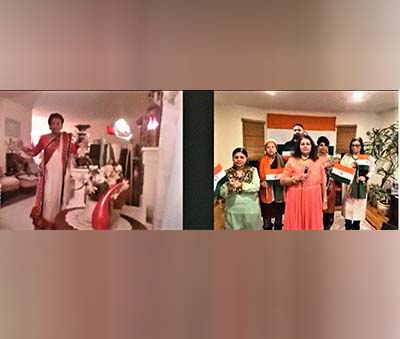 In his inaugural address, Indian Consul General Randhir Kumar Jaiswal, a career diplomat with over two decades of diplomatic career serving in Portugal, Cuba, South Africa and at the Permanent Mission of India in New York, greeted the Diaspora in the United States and around the world on the occasion of India’s 73rd Republic Day celebrations.
In his inaugural address, Indian Consul General Randhir Kumar Jaiswal, a career diplomat with over two decades of diplomatic career serving in Portugal, Cuba, South Africa and at the Permanent Mission of India in New York, greeted the Diaspora in the United States and around the world on the occasion of India’s 73rd Republic Day celebrations.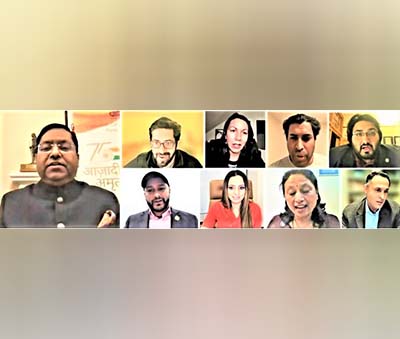 Referring to the several elected Indian American leaders who attended the event, Ambassador Jaiswal said, “Your presence and greetings mean a lot to us and to the Indian Diaspora and to the Indo-US relationship.” Announcing that India has provided 1.6 Billion does of Covid vaccination in the past 1 year, the senior diplomat representing India told the participants, how India’s economy is doing remarkably well and that there are 60,000 StartUP Companies established in the past year. He praised India’s efforts towards women’s empowerment as India continues to contribute towards world peace and prosperity.
Referring to the several elected Indian American leaders who attended the event, Ambassador Jaiswal said, “Your presence and greetings mean a lot to us and to the Indian Diaspora and to the Indo-US relationship.” Announcing that India has provided 1.6 Billion does of Covid vaccination in the past 1 year, the senior diplomat representing India told the participants, how India’s economy is doing remarkably well and that there are 60,000 StartUP Companies established in the past year. He praised India’s efforts towards women’s empowerment as India continues to contribute towards world peace and prosperity.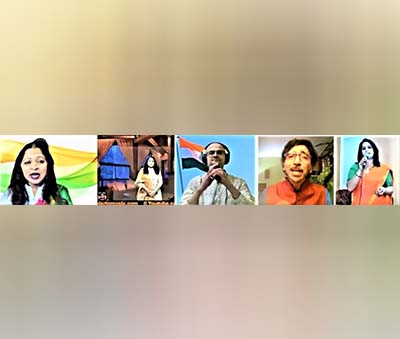 Kesha Ram, Burlington, Vermont, VT State Senator, shared of the reasons for her entering politics. “I got engaged with the community for long, where we care for each other.” One of the youngest ever to be elected to State Assembly at the age of 21, she said, “I am the first ever woman of color top be elected to the state Assembly in Vermont. Continuing to break through the barriers, we can work together to elect more NRIs. “It’s incredible to be of public service, following in the footsteps of my great grandfathers, ” she said, referring to her ancestry back in India, who had fought for the freedom for India. “We have carried with us that spirit of community service.”
Kesha Ram, Burlington, Vermont, VT State Senator, shared of the reasons for her entering politics. “I got engaged with the community for long, where we care for each other.” One of the youngest ever to be elected to State Assembly at the age of 21, she said, “I am the first ever woman of color top be elected to the state Assembly in Vermont. Continuing to break through the barriers, we can work together to elect more NRIs. “It’s incredible to be of public service, following in the footsteps of my great grandfathers, ” she said, referring to her ancestry back in India, who had fought for the freedom for India. “We have carried with us that spirit of community service.”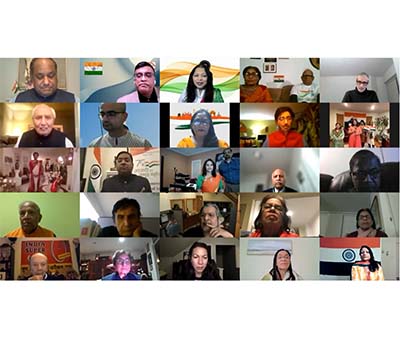 Dr. Jaya Daptardar eloquently emceed the event. American National Anthem was sung by: Mathy Pillai, while the Indian National Anthem was by Jyothi Gupta and team from Long Island. Popular artists from around the world, including Pallavi Belwariar , Kedar Godbole , Srinivas Gunupuru, and Trupti Shah presented popular evergreen patriotic songs such as Vande Mataram and Jai Ho with their beautiful voices. Media Sponsor and Live Streaming was provided by Indus TV (New Jersey). Shivender Sofat, President of GOPIO Manhattan, proposed vote of thanks.
Dr. Jaya Daptardar eloquently emceed the event. American National Anthem was sung by: Mathy Pillai, while the Indian National Anthem was by Jyothi Gupta and team from Long Island. Popular artists from around the world, including Pallavi Belwariar , Kedar Godbole , Srinivas Gunupuru, and Trupti Shah presented popular evergreen patriotic songs such as Vande Mataram and Jai Ho with their beautiful voices. Media Sponsor and Live Streaming was provided by Indus TV (New Jersey). Shivender Sofat, President of GOPIO Manhattan, proposed vote of thanks.
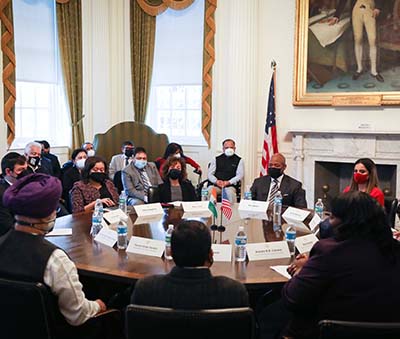 They held discussion on further bolstering the strong partnership between India and the City of New York with special emphasis on key areas including affordable healthcare, renewable energy, new and emerging technology, education and knowledge partnership, IT and fintech.
They held discussion on further bolstering the strong partnership between India and the City of New York with special emphasis on key areas including affordable healthcare, renewable energy, new and emerging technology, education and knowledge partnership, IT and fintech.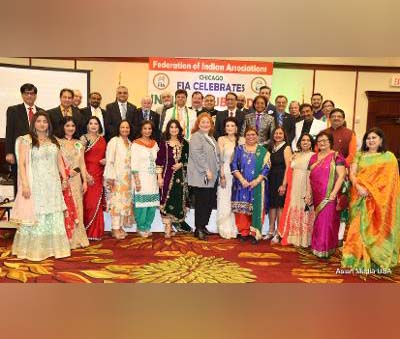 Congressman Raja Krishnamoorthi in his inimitable style addressed the cheering audience and expressed great joy and best wishes to Team FIA and the entire Indian community for the outstanding contributions, over more than a decade now.
Congressman Raja Krishnamoorthi in his inimitable style addressed the cheering audience and expressed great joy and best wishes to Team FIA and the entire Indian community for the outstanding contributions, over more than a decade now.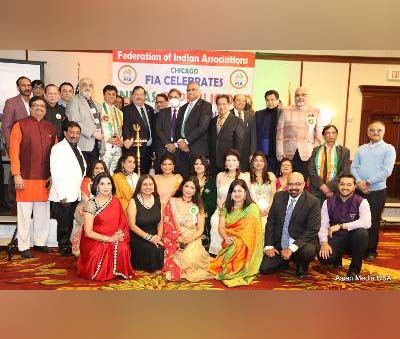 Hitesh Bhatt, Founder & Kim Bhatt, President of the Bhatt Foundation were honored with a Plaque and were acknowledged for their sponsorship support to FIA. In their speech, the Bhatt’s, shared their message of “Improving Global HealthCare and Education through Innovation”. They touched upon their philanthropic work in USA / India / Honduras / Africa and expressed their interest in supporting FIA’s initiatives as well.
Hitesh Bhatt, Founder & Kim Bhatt, President of the Bhatt Foundation were honored with a Plaque and were acknowledged for their sponsorship support to FIA. In their speech, the Bhatt’s, shared their message of “Improving Global HealthCare and Education through Innovation”. They touched upon their philanthropic work in USA / India / Honduras / Africa and expressed their interest in supporting FIA’s initiatives as well.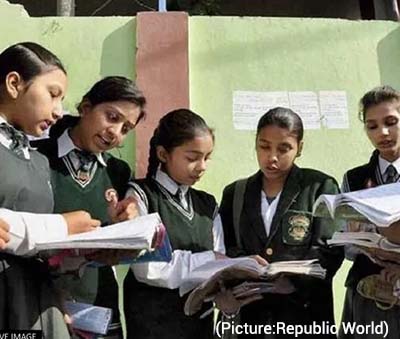 The total fertility rate (TFR), which is an average number of children per women, has also come down to 2 in 2019-21 from 2.2 in 2015-16, as per the Survey.
The total fertility rate (TFR), which is an average number of children per women, has also come down to 2 in 2019-21 from 2.2 in 2015-16, as per the Survey.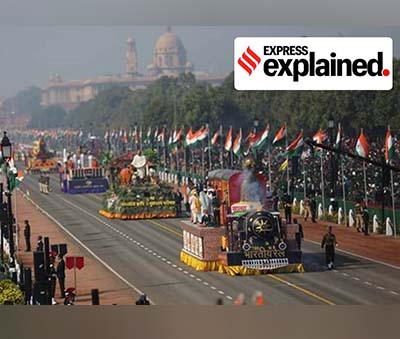 At a time when several Opposition-ruled states complained that their tableaux were not selected for the Republic Day parade, even as the government insisted that the decision was taken by an expert committee and there is no political intervention, the tableaux of four of the five poll-bound states made it to Rajpath on Republic Day.
At a time when several Opposition-ruled states complained that their tableaux were not selected for the Republic Day parade, even as the government insisted that the decision was taken by an expert committee and there is no political intervention, the tableaux of four of the five poll-bound states made it to Rajpath on Republic Day.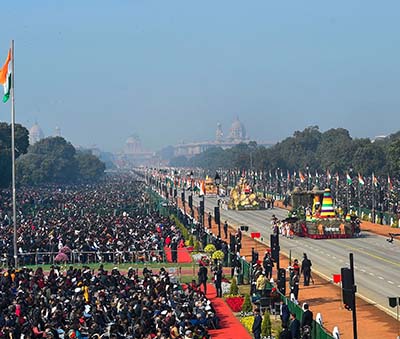 The Air Force tableau paid homage to the victory over Pakistan in the 1971 War, with models of MiG 21, Gnat — both of which were used in the war — and the Light Combat Helicopters. DRDO showcased major weapon platforms developed by it, including the Light Combat Aircraft Tejas and an Air Independent Propulsion system it is working on for the submarines.
The Air Force tableau paid homage to the victory over Pakistan in the 1971 War, with models of MiG 21, Gnat — both of which were used in the war — and the Light Combat Helicopters. DRDO showcased major weapon platforms developed by it, including the Light Combat Aircraft Tejas and an Air Independent Propulsion system it is working on for the submarines. Meanwhile, Goa showed symbols of its heritage and Haryana had a simplistic tableau with several sportsmen from the state on a “victory chariot” carrying the national flag. The idea was to highlight that although it occupies only 1.3 per cent of the country’s landmass and 2.09 per cent of the population, sportsmen from the state have brought maximum medals for the country in various international sporting events, including the Olympics.
Meanwhile, Goa showed symbols of its heritage and Haryana had a simplistic tableau with several sportsmen from the state on a “victory chariot” carrying the national flag. The idea was to highlight that although it occupies only 1.3 per cent of the country’s landmass and 2.09 per cent of the population, sportsmen from the state have brought maximum medals for the country in various international sporting events, including the Olympics.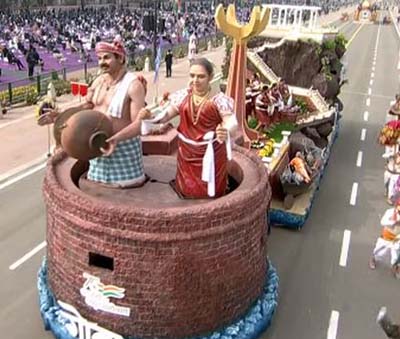 Maharashtra showed the rich biodiversity of the state, with 15 animals and 22 plants as a part of the tableau, including large models of the Blue Mormon Butterfly and more.
Maharashtra showed the rich biodiversity of the state, with 15 animals and 22 plants as a part of the tableau, including large models of the Blue Mormon Butterfly and more.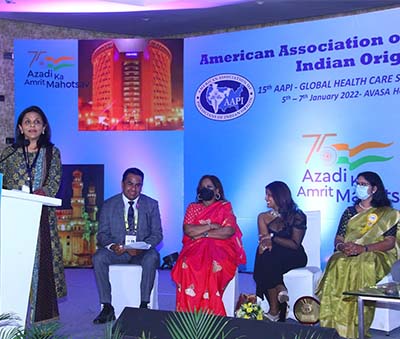 During the much anticipated CEOs Forum, a panel of healthcare experts, health industry leaders, opinion makers, and community organizers discussed the significance of promoting Preventive healthcare in India.
During the much anticipated CEOs Forum, a panel of healthcare experts, health industry leaders, opinion makers, and community organizers discussed the significance of promoting Preventive healthcare in India.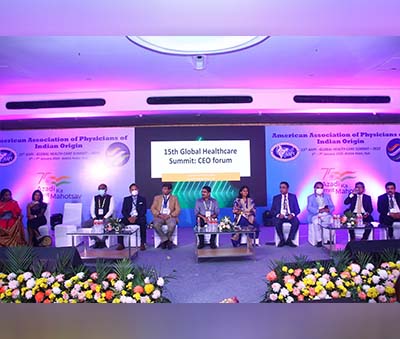 Analyzing and assimilating the diverse and expert views expressed by the renowned speakers at the CEO Forum regarding the current state of healthcare in India, the CEO Forum provided a great stage to interact with a varied and distinct group of individuals and corporations, and comprehend the complex dynamics of the commerce of health care enterprise.
Analyzing and assimilating the diverse and expert views expressed by the renowned speakers at the CEO Forum regarding the current state of healthcare in India, the CEO Forum provided a great stage to interact with a varied and distinct group of individuals and corporations, and comprehend the complex dynamics of the commerce of health care enterprise.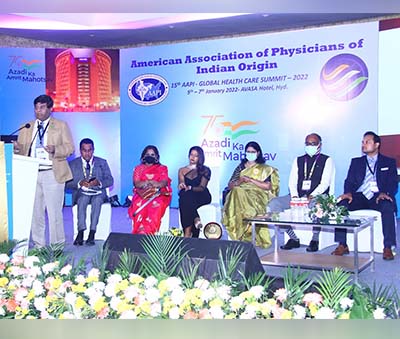 Urging the Government of India to encourage private hospitals and insurance companies to provide Annual Physical exams, or Telehealth visits at an affordable cost to patients, the CEO Forum members stated, “many routine lab tests, vaccinations, blood pressure checks, and some cancer screenings like self-breast examination can be done remotely and even at patients’ homes with the help of Asha
Urging the Government of India to encourage private hospitals and insurance companies to provide Annual Physical exams, or Telehealth visits at an affordable cost to patients, the CEO Forum members stated, “many routine lab tests, vaccinations, blood pressure checks, and some cancer screenings like self-breast examination can be done remotely and even at patients’ homes with the help of Asha 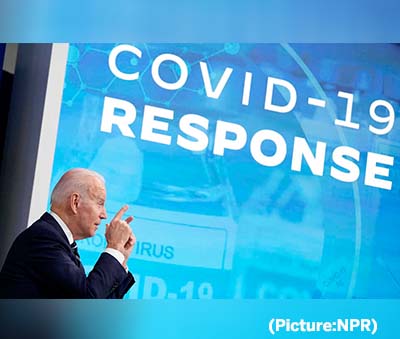 Public health experts and the Centers for Disease Control and Prevention recommend that Americans use at-home tests if they begin to have symptoms, at least five days after coming in close contact with someone who has COVID-19, or are gathering indoors with a group of people who are at risk of severe disease or unvaccinated.
Public health experts and the Centers for Disease Control and Prevention recommend that Americans use at-home tests if they begin to have symptoms, at least five days after coming in close contact with someone who has COVID-19, or are gathering indoors with a group of people who are at risk of severe disease or unvaccinated. Jaya Daptardar, Executive Healthcare Business Consultant, CEO and Founder and a leader of the local CAPI Chapter. The kits included blankets, hats, and socks. The AAPI team raised 2200$ within ten days and accomplished this feat.
Jaya Daptardar, Executive Healthcare Business Consultant, CEO and Founder and a leader of the local CAPI Chapter. The kits included blankets, hats, and socks. The AAPI team raised 2200$ within ten days and accomplished this feat.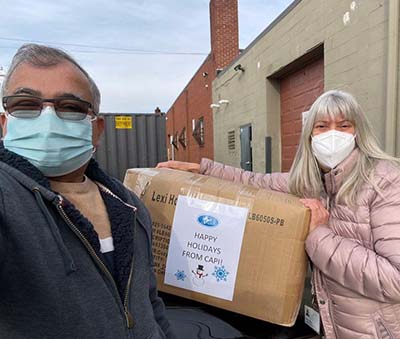 “This was a one of a kind experience for the whole team of physicians and young volunteers alike. Our younger generation of aspirant physicians helped distribute and volunteered their time,” said Dr. Sushil Gupta. “The beneficiaries included children, pregnant women, new moms, and older population.”
“This was a one of a kind experience for the whole team of physicians and young volunteers alike. Our younger generation of aspirant physicians helped distribute and volunteered their time,” said Dr. Sushil Gupta. “The beneficiaries included children, pregnant women, new moms, and older population.”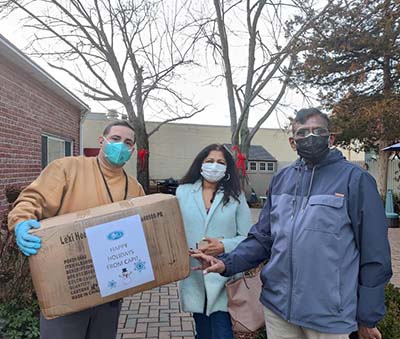 AAPI launched “Share a blanket” project during the holiday season recently to give some warmth to the needy. The project was initially conceptualized by Dr. Binod Sinha, an AAPI member from New Jersey. This project was successful and received very well by the local chapters and communities. For more details and to join the Share A Blanket Drive in your state, please visit:
AAPI launched “Share a blanket” project during the holiday season recently to give some warmth to the needy. The project was initially conceptualized by Dr. Binod Sinha, an AAPI member from New Jersey. This project was successful and received very well by the local chapters and communities. For more details and to join the Share A Blanket Drive in your state, please visit: 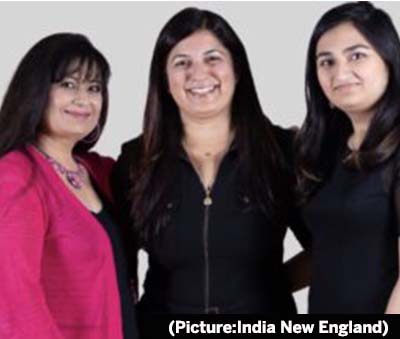 Haitain refugees have faced a significant plight, and there are hundreds of them across Massachusetts, struggling to find basic essentials. A major humanitarian crisis around the world and in our neck of the woods, the Women Who Win team excitedly joined the Gift of Gratitude project on December 19th, an event where they provided vaccine clinics, and other basic essentials like blankets etc. to Haitians in need. We led a shoe donation drive at the event with the Indian Medical Association of New England (IMANE), and were able to donate over 150 shoes to these refugees. The First Haitian-American City Councilor of Boston Ruthzee Louijeane stated, “It was really wonderful to see communities coming together to support our immigrants. We are in a difficult season right now that really asks us to look out for each other. Few things demonstrate that more than welcoming the stranger in our midst.”
Haitain refugees have faced a significant plight, and there are hundreds of them across Massachusetts, struggling to find basic essentials. A major humanitarian crisis around the world and in our neck of the woods, the Women Who Win team excitedly joined the Gift of Gratitude project on December 19th, an event where they provided vaccine clinics, and other basic essentials like blankets etc. to Haitians in need. We led a shoe donation drive at the event with the Indian Medical Association of New England (IMANE), and were able to donate over 150 shoes to these refugees. The First Haitian-American City Councilor of Boston Ruthzee Louijeane stated, “It was really wonderful to see communities coming together to support our immigrants. We are in a difficult season right now that really asks us to look out for each other. Few things demonstrate that more than welcoming the stranger in our midst.”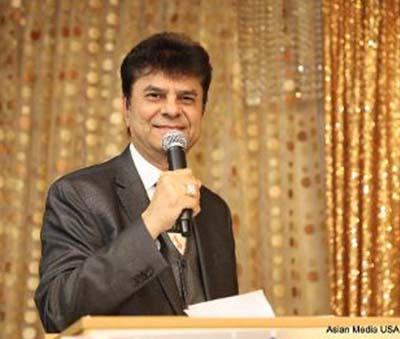 The meeting was focused on the New Year and the New Beginnings under the leadership of President Hitesh Gandhi. Opening speeches were delivered by Sunil Shah, Hitesh Gandhi and Founding Members Mukesh Shah, Rita Singh, Neil Khot, Dhitu Bhagwakar, followed by other members present. There were exciting new updates shared about the upcoming FIA event for celebrating India’s 73rd Republic Day. Date, Venue and other details were discussed. Due to the exponential spread of Covid-19, Team FIA decided that FIA will host a virtual event on Jan 29th, 2022. More to come on that!!
The meeting was focused on the New Year and the New Beginnings under the leadership of President Hitesh Gandhi. Opening speeches were delivered by Sunil Shah, Hitesh Gandhi and Founding Members Mukesh Shah, Rita Singh, Neil Khot, Dhitu Bhagwakar, followed by other members present. There were exciting new updates shared about the upcoming FIA event for celebrating India’s 73rd Republic Day. Date, Venue and other details were discussed. Due to the exponential spread of Covid-19, Team FIA decided that FIA will host a virtual event on Jan 29th, 2022. More to come on that!!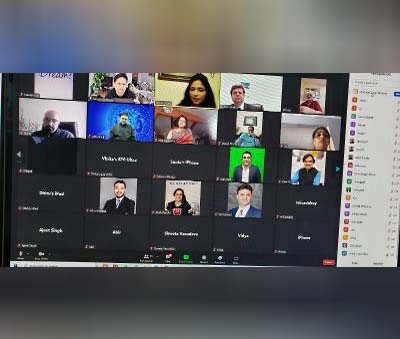 The event started with the Shanti Mantras and Prayers offered by Anu Malhotra and opening condolences speeches by Sunil Shah and Hitesh Gandhi. A tribute video was played, capturing the precious moments in Mir Ali ji’s life (Video Credit: Harry Siddhu, CEO Outland group of Companies). Prominent leaders who also spoke were Neil Khot, Rita Shah, Mukesh Shah, Dhitu Bhgwakar, Smita Shah, Keerthi Reevori, Suresh Bodiwala, Ajeet Singh, Harry Siddhu, Mujeeb Ahmed, Gurmeet Singh Dhalwaan, Vinita Gulabani, Abir Maru, Richa Chand, Ila Chaudhari, Pika Munshi, Jitendra Balsara, Dr Fawaad Ahmad, Malti Pandhi, Monalisha Borghain, Manmeet Kaur, Vidya Joshi, Vikas Kalwani, Chandni Kalra, Dr Afroz Hafeez and many more friends who gave their heartfelt condolences to the cherished friend and colleague that they lost all too sudden. Song video clips of Mir were played several times in between the speeches, that made everyone feel teary eyed, at the same time reminded them of what a fine artist and human being he was.
The event started with the Shanti Mantras and Prayers offered by Anu Malhotra and opening condolences speeches by Sunil Shah and Hitesh Gandhi. A tribute video was played, capturing the precious moments in Mir Ali ji’s life (Video Credit: Harry Siddhu, CEO Outland group of Companies). Prominent leaders who also spoke were Neil Khot, Rita Shah, Mukesh Shah, Dhitu Bhgwakar, Smita Shah, Keerthi Reevori, Suresh Bodiwala, Ajeet Singh, Harry Siddhu, Mujeeb Ahmed, Gurmeet Singh Dhalwaan, Vinita Gulabani, Abir Maru, Richa Chand, Ila Chaudhari, Pika Munshi, Jitendra Balsara, Dr Fawaad Ahmad, Malti Pandhi, Monalisha Borghain, Manmeet Kaur, Vidya Joshi, Vikas Kalwani, Chandni Kalra, Dr Afroz Hafeez and many more friends who gave their heartfelt condolences to the cherished friend and colleague that they lost all too sudden. Song video clips of Mir were played several times in between the speeches, that made everyone feel teary eyed, at the same time reminded them of what a fine artist and human being he was. In continuation of its efforts, during the recently concluded Global Healthcare Summit in Hyderabad, AAPI donated immunoanalyzer at AIIMS, Bibinagar, Telangana, which does hundreds of tests every day. This is part of Covid relief efforts AAPI has taken over during the second wave of pandemic.
In continuation of its efforts, during the recently concluded Global Healthcare Summit in Hyderabad, AAPI donated immunoanalyzer at AIIMS, Bibinagar, Telangana, which does hundreds of tests every day. This is part of Covid relief efforts AAPI has taken over during the second wave of pandemic.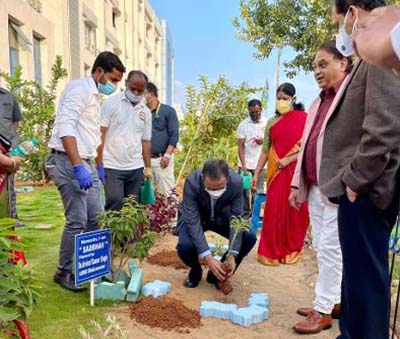 AAPI coordinated with dozens of physicians including primary care physicians, ER, critical care and ID physicians, who see these patients on a constant basis, to help during this crisis. Questions are being sent by email and physicians answer them at the earliest convenience.
AAPI coordinated with dozens of physicians including primary care physicians, ER, critical care and ID physicians, who see these patients on a constant basis, to help during this crisis. Questions are being sent by email and physicians answer them at the earliest convenience.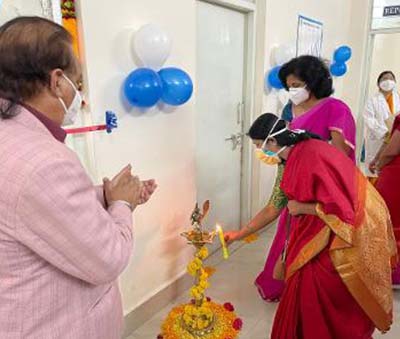 Dr. Anupama Gotimukula, president of AAPI along with Dr. Satheesh Kathula, AAPI secretary, and Dr. Sujeeth Punnam, Chair, Chair, Covid relief committee participated in the inauguration of biochemistry lab/Immunoanalyzer at AIIMS, Bibinagar, Hyderabad. Later on they planted trees in AIIMS Vatika, Bibinagar and named one of them “AAPI”. For more details, please visit:
Dr. Anupama Gotimukula, president of AAPI along with Dr. Satheesh Kathula, AAPI secretary, and Dr. Sujeeth Punnam, Chair, Chair, Covid relief committee participated in the inauguration of biochemistry lab/Immunoanalyzer at AIIMS, Bibinagar, Hyderabad. Later on they planted trees in AIIMS Vatika, Bibinagar and named one of them “AAPI”. For more details, please visit:  “During the 15th annual Global Healthcare Summit, organized in Hyderabad, India from January 5th to 7th, 2022, physician leaders from the United States and India had an opportunity to brainstorm and explore ways to focus on the theme, “Transformation of Healthcare through Telehealth and Technology usage during this post-Covid Era,” and have recommended possible ways to plan and implement preventive medicine that will save resources and precious human lives,” said Dr. Anupama Gotimukula, President of AAPI.
“During the 15th annual Global Healthcare Summit, organized in Hyderabad, India from January 5th to 7th, 2022, physician leaders from the United States and India had an opportunity to brainstorm and explore ways to focus on the theme, “Transformation of Healthcare through Telehealth and Technology usage during this post-Covid Era,” and have recommended possible ways to plan and implement preventive medicine that will save resources and precious human lives,” said Dr. Anupama Gotimukula, President of AAPI. “With numerous initiatives, AAPI has come a long way since its inception and has proved to be beneficial not only to Indian-origin American Physicians, but to Indian healthcare as well,” Mr. Naidu observed. He urged the medical fraternity and told them, “as you seek excellence in human health and well-being, do not forget the power of a kind human touch when treating your patients.”
“With numerous initiatives, AAPI has come a long way since its inception and has proved to be beneficial not only to Indian-origin American Physicians, but to Indian healthcare as well,” Mr. Naidu observed. He urged the medical fraternity and told them, “as you seek excellence in human health and well-being, do not forget the power of a kind human touch when treating your patients.”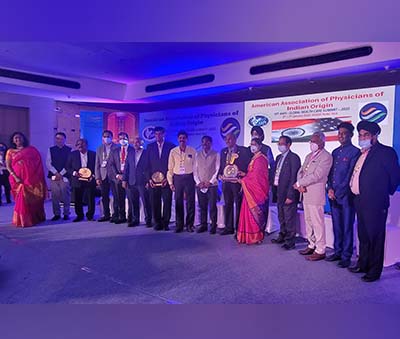 The groundbreaking Global Healthcare Summit (GHS) organized by AAPI in collaboration with the Government of India, BAPIO & GAPIO, as well as Host Alumni Chapters, including OGKTMA, ATMGUSA, KAMCOSA, and GMCGA, was packed with programs that were treat to the hearts and souls of every participant.
The groundbreaking Global Healthcare Summit (GHS) organized by AAPI in collaboration with the Government of India, BAPIO & GAPIO, as well as Host Alumni Chapters, including OGKTMA, ATMGUSA, KAMCOSA, and GMCGA, was packed with programs that were treat to the hearts and souls of every participant. Dr. Ravi Kolli, President-Elect f AAPI said, “We have made great strides in helping people to live longer, however, people are spending too many years in poor health, and these gains in health not felt equally across society. We need to focus on the rising levels of obesity, mental illness, addictions, age-related conditions like dementia, and a growing, ageing, and diverse populations, We also need to be aware of cyberbullying, pervasive misinformation and other harmful social media influences affecting our youth.”
Dr. Ravi Kolli, President-Elect f AAPI said, “We have made great strides in helping people to live longer, however, people are spending too many years in poor health, and these gains in health not felt equally across society. We need to focus on the rising levels of obesity, mental illness, addictions, age-related conditions like dementia, and a growing, ageing, and diverse populations, We also need to be aware of cyberbullying, pervasive misinformation and other harmful social media influences affecting our youth.”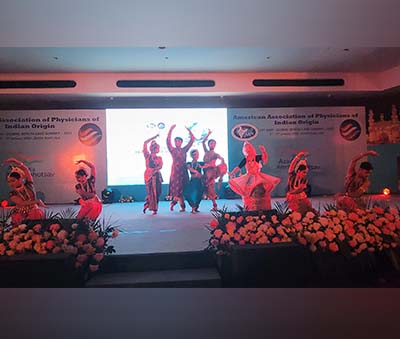 Dr. Krishan Kumar, Treasurer of AAPI, pointed out, “India, thus needs to redouble and continue its efforts and dedicate resources to tackle these perennial challenges. Many of these projects and programs need regular funding, and management of resources. We are grateful to dozens of AAPI members who have committed to serve India with an ongoing commitment.”
Dr. Krishan Kumar, Treasurer of AAPI, pointed out, “India, thus needs to redouble and continue its efforts and dedicate resources to tackle these perennial challenges. Many of these projects and programs need regular funding, and management of resources. We are grateful to dozens of AAPI members who have committed to serve India with an ongoing commitment.”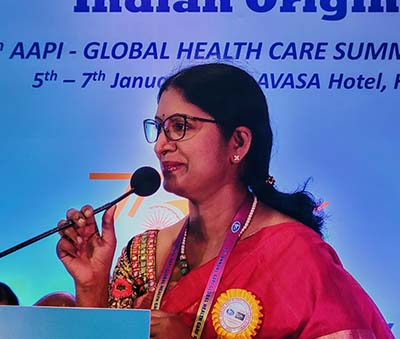 The topics for CMEs broadly covered the recent advances in Medicine. Workshops on Medical Education and Reforms in India, Psychiatry, Palliative Care and Diabetes as well the seminar on Lifestyle Medicine led by world renowned leader and founder of Life Style Medicine, Dr. Neil Bernard were educative and offered new awareness on trends in medicine and healthier living. The Tuberclosis Awareness Seminar focused on recent advances in the TB epidemic.
The topics for CMEs broadly covered the recent advances in Medicine. Workshops on Medical Education and Reforms in India, Psychiatry, Palliative Care and Diabetes as well the seminar on Lifestyle Medicine led by world renowned leader and founder of Life Style Medicine, Dr. Neil Bernard were educative and offered new awareness on trends in medicine and healthier living. The Tuberclosis Awareness Seminar focused on recent advances in the TB epidemic.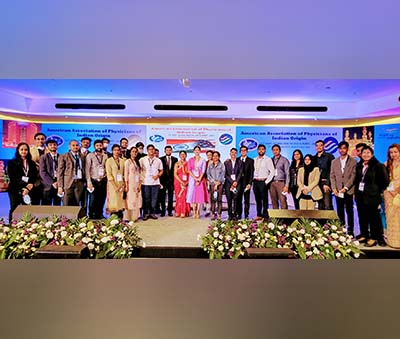 The CEO Forum, chaired by Dr. Joseph Chalil had a galaxy of CEOs from India and the United States, who shared their insights into the challenges and opportunities for making healthcare affordable, using modern technology and scientific research, Sangita Reddy, Joint MD of Apollo group of hospitals and incoming Chairman of FICCI shared her passion for the care of the masses, using technology to reach out. She praised AAPI’s efforts to help India through its Healthcare Summits in making policies in healthcare delivery more effective.
The CEO Forum, chaired by Dr. Joseph Chalil had a galaxy of CEOs from India and the United States, who shared their insights into the challenges and opportunities for making healthcare affordable, using modern technology and scientific research, Sangita Reddy, Joint MD of Apollo group of hospitals and incoming Chairman of FICCI shared her passion for the care of the masses, using technology to reach out. She praised AAPI’s efforts to help India through its Healthcare Summits in making policies in healthcare delivery more effective.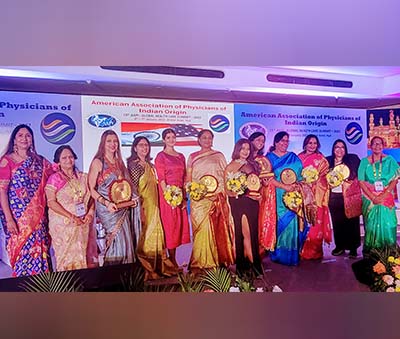 “January is #CervicalCancer Awareness Month! In coordination with the local organizers of the GHS, AAPI is donating funds for the HPV Vaccination, a total of 200 doses of the vaccine for 100 children from the state of Telangana on January 9th,” said Dr. Meher Medavaram, an organizer of the program. “AAPI’s this new initiative through education and awareness programs, is aimed at help save millions of lives in India,” she added.
“January is #CervicalCancer Awareness Month! In coordination with the local organizers of the GHS, AAPI is donating funds for the HPV Vaccination, a total of 200 doses of the vaccine for 100 children from the state of Telangana on January 9th,” said Dr. Meher Medavaram, an organizer of the program. “AAPI’s this new initiative through education and awareness programs, is aimed at help save millions of lives in India,” she added.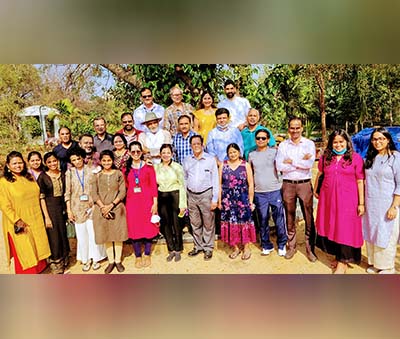 The Pre-Tour of the GHS 2019 took the delegates to the serene Kanha Shanti Vanam, located in the suburbs of Hyderabad. Magnificent in its conception and design, tranquil in its atmosphere, Kanha, blending the beauty of nature with sprawling facilities gave an inspiring experience to AAPI members an opportunity to learn to relax and meditate, through the Heartfulness movement.
The Pre-Tour of the GHS 2019 took the delegates to the serene Kanha Shanti Vanam, located in the suburbs of Hyderabad. Magnificent in its conception and design, tranquil in its atmosphere, Kanha, blending the beauty of nature with sprawling facilities gave an inspiring experience to AAPI members an opportunity to learn to relax and meditate, through the Heartfulness movement.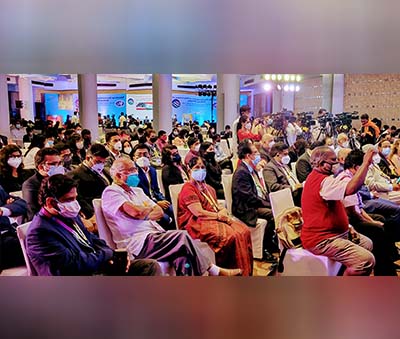 During his address to the AAPI delegates on Jan 6th, DAAJI inspired the audience with his enriching address focusing on modern day life, the stressors and the challenges, while offering insights into how stress relaxation, meditation and cleansing would help human beings lead a peaceful life.
During his address to the AAPI delegates on Jan 6th, DAAJI inspired the audience with his enriching address focusing on modern day life, the stressors and the challenges, while offering insights into how stress relaxation, meditation and cleansing would help human beings lead a peaceful life.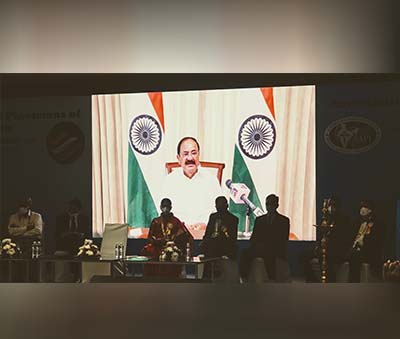
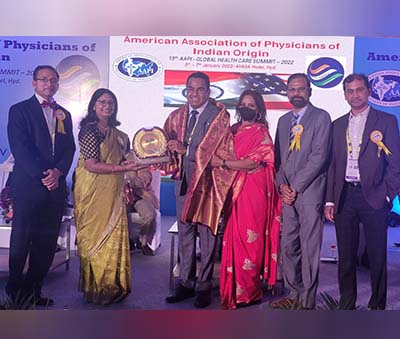
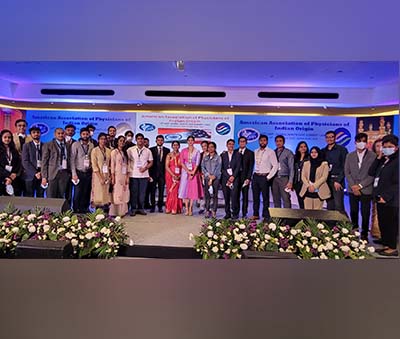 “With numerous initiatives, AAPI has come a long way since its inception and has proved to be beneficial not only to Indian-origin American Physicians, but to Indian healthcare as well,” Mr. Naidu observed. He urged the medical fraternity and told them, “as you seek excellence in human health and well-being, do not forget the power of a kind human touch when treating your patients.”
“With numerous initiatives, AAPI has come a long way since its inception and has proved to be beneficial not only to Indian-origin American Physicians, but to Indian healthcare as well,” Mr. Naidu observed. He urged the medical fraternity and told them, “as you seek excellence in human health and well-being, do not forget the power of a kind human touch when treating your patients.” In her welcome address, Dr. Anupama Gotimukula, President of AAPI, said, “This year’s Summit is focused on the theme: “Prevention is better than cure” through Technology, Telemedicine, and Transformation from the current disease-care system to a preventive healthcare system.” Dr. Gotimukula, who has chosen to focus on the “Adopt a Village” Rural Preventive Healthcare screening initiative, stated that “AAPI has brought to the attention of the Government of India the need for preventive health care screening to help detect diseases at an early stage and our purpose of the Global health summit is to interact and collaborate with Government of India and emphasize the need of annual preventive healthcare screening and have the healthcare accessible and affordable.”
In her welcome address, Dr. Anupama Gotimukula, President of AAPI, said, “This year’s Summit is focused on the theme: “Prevention is better than cure” through Technology, Telemedicine, and Transformation from the current disease-care system to a preventive healthcare system.” Dr. Gotimukula, who has chosen to focus on the “Adopt a Village” Rural Preventive Healthcare screening initiative, stated that “AAPI has brought to the attention of the Government of India the need for preventive health care screening to help detect diseases at an early stage and our purpose of the Global health summit is to interact and collaborate with Government of India and emphasize the need of annual preventive healthcare screening and have the healthcare accessible and affordable.” “We thank all the AAPI Members who are sparing their valuable time to come over to Hyderabad in order to attend this event, despite the ongoing situation of the existence of Omicron and travel restrictions. We really appreciate this gesture of courage and confidence displayed by you on behalf of Local Org. Committee, for braving odds and attending the 15th Annual AAPI GHS, Hyderabad. This is highly admirable,” said Dr. D. Dwarakanatha Reddy, India Chair, AAPI GHS 2022.
“We thank all the AAPI Members who are sparing their valuable time to come over to Hyderabad in order to attend this event, despite the ongoing situation of the existence of Omicron and travel restrictions. We really appreciate this gesture of courage and confidence displayed by you on behalf of Local Org. Committee, for braving odds and attending the 15th Annual AAPI GHS, Hyderabad. This is highly admirable,” said Dr. D. Dwarakanatha Reddy, India Chair, AAPI GHS 2022.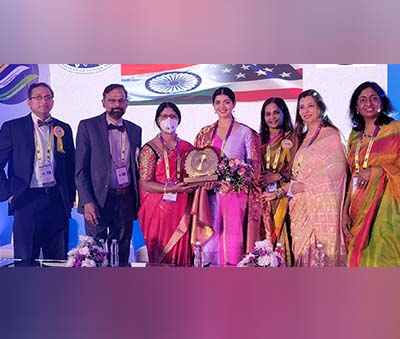 Dr. Krishan Kumar, Treasurer of AAPI, pointed out, “India, thus needs to redouble and continue its efforts and dedicate resources to tackle these perennial challenges. Many of these projects and programs need regular funding, and management of resources. We are grateful to dozens of AAPI members who have committed to serve India with an ongoing commitment.”
Dr. Krishan Kumar, Treasurer of AAPI, pointed out, “India, thus needs to redouble and continue its efforts and dedicate resources to tackle these perennial challenges. Many of these projects and programs need regular funding, and management of resources. We are grateful to dozens of AAPI members who have committed to serve India with an ongoing commitment.” Calling it an important initiative, he praised AAPI for its “awareness program for CPR (Cardiopulmonary Resuscitation). At a time of increasing share of Non-Communicable Diseases, especially those related to the heart, we need greater awareness among people to apply CPR as a lifesaving first-aid technique and save lives during heart attacks or near drowning. I believe school children, at least at higher secondary level, and in fact, every citizen, must be taught CPR along with other basic aspects of first-aid,” her added.
Calling it an important initiative, he praised AAPI for its “awareness program for CPR (Cardiopulmonary Resuscitation). At a time of increasing share of Non-Communicable Diseases, especially those related to the heart, we need greater awareness among people to apply CPR as a lifesaving first-aid technique and save lives during heart attacks or near drowning. I believe school children, at least at higher secondary level, and in fact, every citizen, must be taught CPR along with other basic aspects of first-aid,” her added.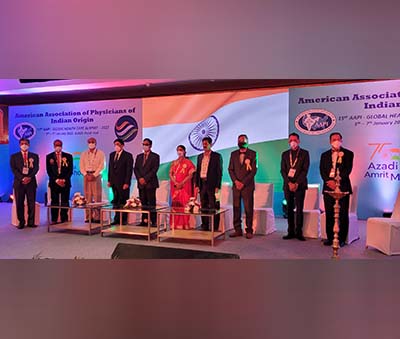 These Indian-origin physicians are a personification of our nation’s cherished civilisational value of ‘Vasudhaiva Kutumbakam’. They are among the most successful ambassadors of India’s value systems and propagators of our mission to ‘Share and Care’ for all the people of the world, irrespective of their nationalities. We are indeed proud of them and their services.
These Indian-origin physicians are a personification of our nation’s cherished civilisational value of ‘Vasudhaiva Kutumbakam’. They are among the most successful ambassadors of India’s value systems and propagators of our mission to ‘Share and Care’ for all the people of the world, irrespective of their nationalities. We are indeed proud of them and their services.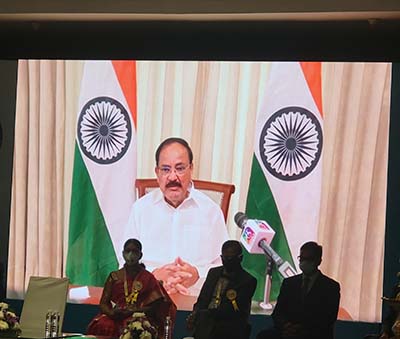 To bridge the gap between urban and rural communities, the Vice President suggested seriously exploring the use of telehealth and other technological solutions in reaching out better to rural and remote areas. “This will expand the utilization of our limited manpower and health infrastructure to reach the last mile,” he said.
To bridge the gap between urban and rural communities, the Vice President suggested seriously exploring the use of telehealth and other technological solutions in reaching out better to rural and remote areas. “This will expand the utilization of our limited manpower and health infrastructure to reach the last mile,” he said.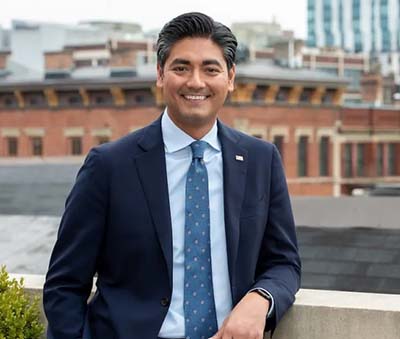 Pureval is to be sworn in as Mayor of the City of Cincinnati on January 4, 2022. “We are so grateful for the many reforms and the leadership Aftab Pureval has brought to the Clerk of Court’s office since he was elected in 2016 and re-elected in 2020,” said Gwen McFarlin, Chair of the Hamilton County Democratic Party.
Pureval is to be sworn in as Mayor of the City of Cincinnati on January 4, 2022. “We are so grateful for the many reforms and the leadership Aftab Pureval has brought to the Clerk of Court’s office since he was elected in 2016 and re-elected in 2020,” said Gwen McFarlin, Chair of the Hamilton County Democratic Party.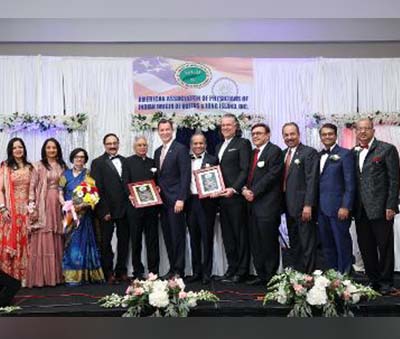 The United States Senate Majority Leader Chuck Schumer, chief guest at the event, in his address, praised the contributions of Indian Americans to the larger American society. He lauded the great contributions of the largest AAPI Chapter with over 850 Member Physicians, who serve the state of New York in various capacities. “For 25 years, members of AAPI QLI has worked tirelessly to support Indian American physicians excel in patient care , teaching and research,” he said.
The United States Senate Majority Leader Chuck Schumer, chief guest at the event, in his address, praised the contributions of Indian Americans to the larger American society. He lauded the great contributions of the largest AAPI Chapter with over 850 Member Physicians, who serve the state of New York in various capacities. “For 25 years, members of AAPI QLI has worked tirelessly to support Indian American physicians excel in patient care , teaching and research,” he said.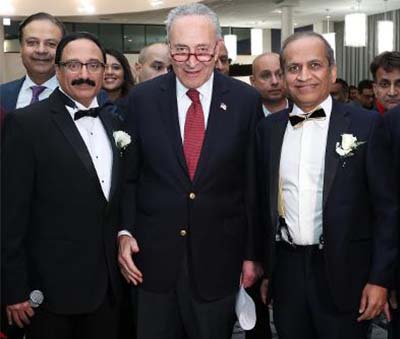 “I am grateful anmd stand here with adeep sense of gratitude and appreciation. You all esteemed members of AAPI QLI have given me tremendous opportunity to be your president during the very special year a silver jubilee year of AAPIQLI and to serve as the Chair of the Jubilee Celebrations. It has been my pleasure and very special privilege to serve as your president during silver jubilee year of AAPIQLI.”
“I am grateful anmd stand here with adeep sense of gratitude and appreciation. You all esteemed members of AAPI QLI have given me tremendous opportunity to be your president during the very special year a silver jubilee year of AAPIQLI and to serve as the Chair of the Jubilee Celebrations. It has been my pleasure and very special privilege to serve as your president during silver jubilee year of AAPIQLI.”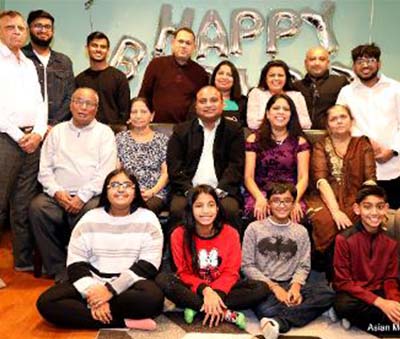 Born in the historical year of India’s Independence, 1947, to Shri Govind Lal Kothari and Smt. Sharda Kothari, in a small town of Gujarat called Kadi, Hasmukh finished his education with a degree in Civil Engineering, after which he procured a job as an assistant lecturer in Mumbai. In 1968, Hasmukh married Usha to start a blissful family life.
Born in the historical year of India’s Independence, 1947, to Shri Govind Lal Kothari and Smt. Sharda Kothari, in a small town of Gujarat called Kadi, Hasmukh finished his education with a degree in Civil Engineering, after which he procured a job as an assistant lecturer in Mumbai. In 1968, Hasmukh married Usha to start a blissful family life. The Indian American community-focused program was jointly developed by Dr. Vemuri S Murthy, Chairman of the Board of Chicago Medical Society and Founder of the Chicago Medical Society Community Bystander CPR project “SMILE” (Saving More Illinois Lives through Education) in association with Dr. Srinivas Ramaka, an eminent Cardiologist from Telangana, India. The program was attended by several members of the Indian diaspora, leaders of Medical Organizations, and Diplomats of the Indian Consulate, staff, and families.
The Indian American community-focused program was jointly developed by Dr. Vemuri S Murthy, Chairman of the Board of Chicago Medical Society and Founder of the Chicago Medical Society Community Bystander CPR project “SMILE” (Saving More Illinois Lives through Education) in association with Dr. Srinivas Ramaka, an eminent Cardiologist from Telangana, India. The program was attended by several members of the Indian diaspora, leaders of Medical Organizations, and Diplomats of the Indian Consulate, staff, and families.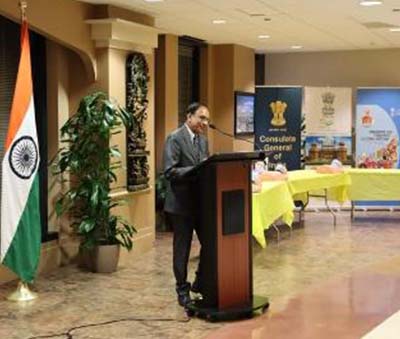 In his address, Hon’ble Member of Congress Danny K. Davis stressed the importance of taking care of one’s health. He commended the significant role of the Indian American doctors in contributing to the general health and well-being of US communities. In a virtual message, Honorable Congressman Raja Krishnamoorthi congratulated the Indian Consulate and Dr. Vemuri Murthy for organizing the program and their efforts to enhance outcomes after cardiac arrests among the communities.
In his address, Hon’ble Member of Congress Danny K. Davis stressed the importance of taking care of one’s health. He commended the significant role of the Indian American doctors in contributing to the general health and well-being of US communities. In a virtual message, Honorable Congressman Raja Krishnamoorthi congratulated the Indian Consulate and Dr. Vemuri Murthy for organizing the program and their efforts to enhance outcomes after cardiac arrests among the communities.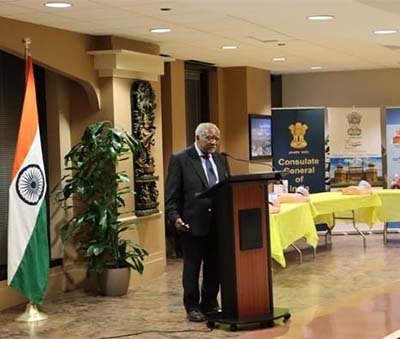 Efforts to raise awareness of heart disease and promote “Healthy Heart” lifestyles is essential. Heart disease is the number one Global Public Health problem. South Asians are at a four-times greater risk of heart disease than their western counterparts and have a greater chance of having a heart attack before 50 years of age. Heart attacks strike South Asian Men and Women at younger ages, and as a result, both morbidity and mortality are higher among them compared to any other ethnic group. They tend to develop heart disease ten years earlier than other groups.
Efforts to raise awareness of heart disease and promote “Healthy Heart” lifestyles is essential. Heart disease is the number one Global Public Health problem. South Asians are at a four-times greater risk of heart disease than their western counterparts and have a greater chance of having a heart attack before 50 years of age. Heart attacks strike South Asian Men and Women at younger ages, and as a result, both morbidity and mortality are higher among them compared to any other ethnic group. They tend to develop heart disease ten years earlier than other groups.
 While COVID-19 clearly played a role in this near-zero population growth, that growth had begun to plummet even before the pandemic. The 2020 census showed that from 2010 to 2020, the U.S. registered the
While COVID-19 clearly played a role in this near-zero population growth, that growth had begun to plummet even before the pandemic. The 2020 census showed that from 2010 to 2020, the U.S. registered the 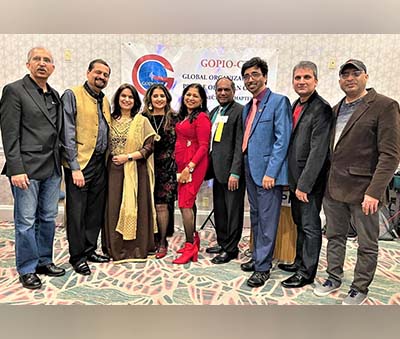 “As the pandemic was coming down in the year, the chapter organized several programs with physical presence participating with other ethnic communities celebrating Stamford’s founding, and organizing Indian and American flag hoisting at Govt. Center in Stamford to celebrate India’s 75th Independence Day which was followed by an India Festival at the Mill River Park, hosting UConn Indian students for a Networking Welcome Dinner, an interactive session with India’s Minister of State for External Affairs V. Muraleedharan, Hosting a Conversation with Indra Nooyi and a Diwali fundraiser for local charities,” added President Nichani.
“As the pandemic was coming down in the year, the chapter organized several programs with physical presence participating with other ethnic communities celebrating Stamford’s founding, and organizing Indian and American flag hoisting at Govt. Center in Stamford to celebrate India’s 75th Independence Day which was followed by an India Festival at the Mill River Park, hosting UConn Indian students for a Networking Welcome Dinner, an interactive session with India’s Minister of State for External Affairs V. Muraleedharan, Hosting a Conversation with Indra Nooyi and a Diwali fundraiser for local charities,” added President Nichani. The fundraiser netted $5,500 to give to the local service organization Grassroots Tennis and Education, a youth development non-profit organization that uses sports of tennis to engage youth in out-of-school time programming in Norwalk and Stamford. The group’s volunteers teach tennis and helps students in education. Grassroots’ representative Ms. Samantha Hayes spoke about the organization and thanked GOPIO-CT for its generosity in raising funds for Grassroots. Another organization IT Serve Alliance also presented a check of $2,000 to Grassroots.
The fundraiser netted $5,500 to give to the local service organization Grassroots Tennis and Education, a youth development non-profit organization that uses sports of tennis to engage youth in out-of-school time programming in Norwalk and Stamford. The group’s volunteers teach tennis and helps students in education. Grassroots’ representative Ms. Samantha Hayes spoke about the organization and thanked GOPIO-CT for its generosity in raising funds for Grassroots. Another organization IT Serve Alliance also presented a check of $2,000 to Grassroots.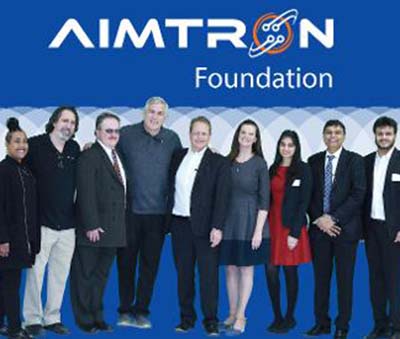 At the celebration, guests learned about Aimtron Foundation’s mission to bridge the educational gap for young people and their plan to provide manufacturing and technological training in an ever-changing world. They will do this by partnering with other manufacturing industry leaders who will give tours of their facilities, share knowledge and training and ultimately, offer employment opportunities to develop the workforce of the future. Guests were also able to tour the new 35,000 square foot American Pinball facility and learn more about the technology and building of pinball gaming machines.
At the celebration, guests learned about Aimtron Foundation’s mission to bridge the educational gap for young people and their plan to provide manufacturing and technological training in an ever-changing world. They will do this by partnering with other manufacturing industry leaders who will give tours of their facilities, share knowledge and training and ultimately, offer employment opportunities to develop the workforce of the future. Guests were also able to tour the new 35,000 square foot American Pinball facility and learn more about the technology and building of pinball gaming machines.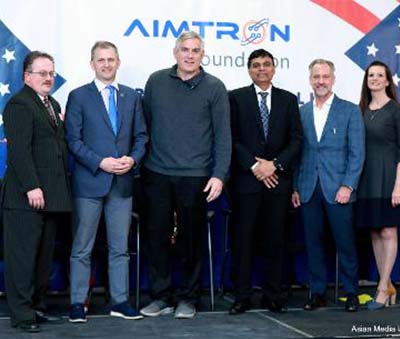 Mukesh Vasani, a devout family man with two married children who hold leadership positions at the company, founded Aimtron Corporation (now Aimtron Group) in 2008, at the height of the worst economic downturn since the great depression. His vision of starting Aimtron Foundation to kindle the entrepreneurial spark within the next generation is the realization of a dream born from his family, who were farmers back in India.
Mukesh Vasani, a devout family man with two married children who hold leadership positions at the company, founded Aimtron Corporation (now Aimtron Group) in 2008, at the height of the worst economic downturn since the great depression. His vision of starting Aimtron Foundation to kindle the entrepreneurial spark within the next generation is the realization of a dream born from his family, who were farmers back in India.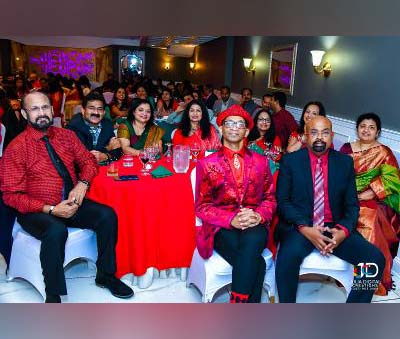 “Life is better with friends,” Jacob Abraham told the participants in his welcome address, providing insight into the objectives of creating the Hedge Social Club. “Friends are the ones who know you and are always there when you need them most. During the pandemic times, a sense of community is more important now than ever before. People near you are looking to form connections and find support.”
“Life is better with friends,” Jacob Abraham told the participants in his welcome address, providing insight into the objectives of creating the Hedge Social Club. “Friends are the ones who know you and are always there when you need them most. During the pandemic times, a sense of community is more important now than ever before. People near you are looking to form connections and find support.”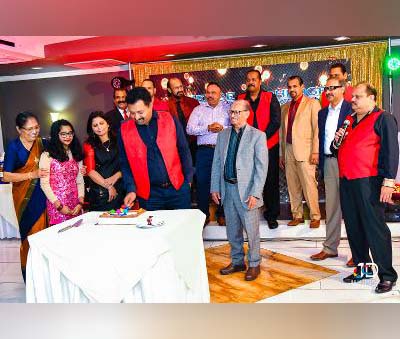 Senator Kevin Thomas of the New York State greeted the audience. Guest of Honor was Dr. Freemu Varghese, Founder and CEO of Freedia Media. Minos Abraham served eloquently as the Emcee for the program. Biju Chacko, a BOD member of IAPC introduced Jacob Abraham to the audience.
Senator Kevin Thomas of the New York State greeted the audience. Guest of Honor was Dr. Freemu Varghese, Founder and CEO of Freedia Media. Minos Abraham served eloquently as the Emcee for the program. Biju Chacko, a BOD member of IAPC introduced Jacob Abraham to the audience. Stating that Hedge Club is a forum to “Meet new people at the Hedge Club, which is the ultimate group” Jacob Abraham said, “HEDGE CLUB is the one you always wanted to be part of. A group that you feel you belong to, and you believe it to be an integral part of who you are.” The Club members meet every month and celebrate and enhance their fellowship and joy. To join the Group and expand one’s friends circle and spend quality time with people, please call Saji Abraham at: 516. 606.3268.
Stating that Hedge Club is a forum to “Meet new people at the Hedge Club, which is the ultimate group” Jacob Abraham said, “HEDGE CLUB is the one you always wanted to be part of. A group that you feel you belong to, and you believe it to be an integral part of who you are.” The Club members meet every month and celebrate and enhance their fellowship and joy. To join the Group and expand one’s friends circle and spend quality time with people, please call Saji Abraham at: 516. 606.3268.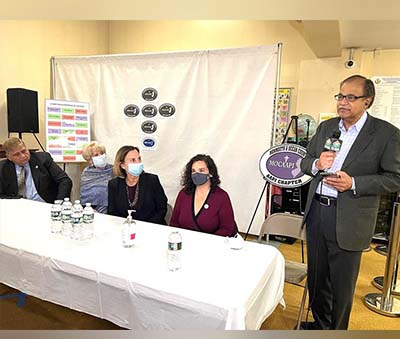 “It was a long-time dream of MOCAAPI members to make an impactful donation which is being fulfilled today by making a $150,000 donation to Fulfill Food Bank of Monmouth Ocean Counties and $150,000 to the Indian Cultural & Community Center to build a much-needed Community Hall in Toms River,” MOCAAPI President Dr. Avinash Gupta is quoted saying in the press release.
“It was a long-time dream of MOCAAPI members to make an impactful donation which is being fulfilled today by making a $150,000 donation to Fulfill Food Bank of Monmouth Ocean Counties and $150,000 to the Indian Cultural & Community Center to build a much-needed Community Hall in Toms River,” MOCAAPI President Dr. Avinash Gupta is quoted saying in the press release.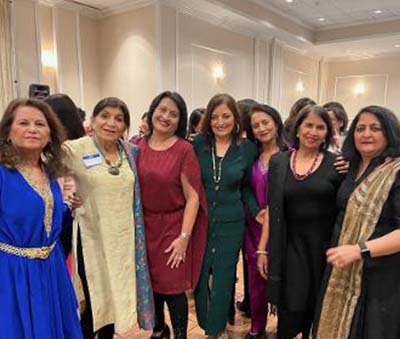 The program was beautifully planned by Sarita Sood, Tara Swaminathan and Vinita Gulabani under the leadership of CIW vice president Preeti Chawla and superbly anchored by Vinita Gulabani. During breaks for delicious appetizers and a sumptuous lunch, attendees had a chance to catch up with old friends and make new ones.
The program was beautifully planned by Sarita Sood, Tara Swaminathan and Vinita Gulabani under the leadership of CIW vice president Preeti Chawla and superbly anchored by Vinita Gulabani. During breaks for delicious appetizers and a sumptuous lunch, attendees had a chance to catch up with old friends and make new ones.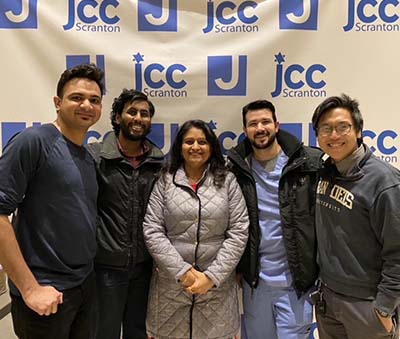 ”This drive was a team effort on the part of Dr. Kishori Veerabhadrappa, Dr. Sanket Dalwadi, Dr. Jumee Barooha and Red Cross representative Heidi Deleo,” Dr. Pancholi added. Excited about the very positive and encouraging support from the community, Dr. Pancholi said, “We plan to conduct future blood drives in the 11 counties that north eastern Pennsylvania.
”This drive was a team effort on the part of Dr. Kishori Veerabhadrappa, Dr. Sanket Dalwadi, Dr. Jumee Barooha and Red Cross representative Heidi Deleo,” Dr. Pancholi added. Excited about the very positive and encouraging support from the community, Dr. Pancholi said, “We plan to conduct future blood drives in the 11 counties that north eastern Pennsylvania. “On the occasion of the 75thIndependence Day of India, we the physicians of Indian origin serving every 7th patient in the United States, are excited to launch this unique and noble initiative and Stem Cell Drive” in 75 cities across the United States,” Dr. Gotimukula added.
“On the occasion of the 75thIndependence Day of India, we the physicians of Indian origin serving every 7th patient in the United States, are excited to launch this unique and noble initiative and Stem Cell Drive” in 75 cities across the United States,” Dr. Gotimukula added. “Thank you all for your generous support and help in making the Blood Drive very successful,” said Dr. Jaya Daptardar. ”This drive was a team effort. I want to express my gratitude to Dr. Sushil Gupta, President of CAAPI, Dr. Subbarao Bollepalli, Viji Kurup and family members of CAPI, who came in attendance and to donate blood and support this noble initiative.” “I am grateful to First Selectwoman of Weston Samantha Nestor and Toni Boucher for gracing the event with their presence and for their support,” said Dr. Ram Chirunomula.
“Thank you all for your generous support and help in making the Blood Drive very successful,” said Dr. Jaya Daptardar. ”This drive was a team effort. I want to express my gratitude to Dr. Sushil Gupta, President of CAAPI, Dr. Subbarao Bollepalli, Viji Kurup and family members of CAPI, who came in attendance and to donate blood and support this noble initiative.” “I am grateful to First Selectwoman of Weston Samantha Nestor and Toni Boucher for gracing the event with their presence and for their support,” said Dr. Ram Chirunomula. “On the occasion of the 75thIndependence Day of India, we the physicians of Indian origin serving every 7th patient in the United States, are excited to launch this unique and noble initiative in 75 cities across the United States,” Dr. Gotimukula added.
“On the occasion of the 75thIndependence Day of India, we the physicians of Indian origin serving every 7th patient in the United States, are excited to launch this unique and noble initiative in 75 cities across the United States,” Dr. Gotimukula added.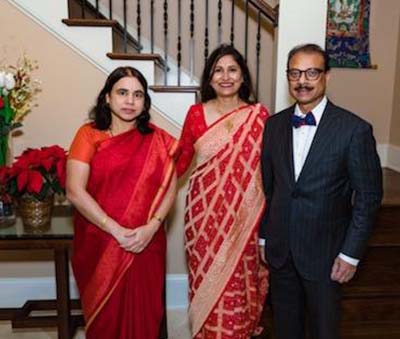 The Pravasi Bharatiya Samman Award (PBSA) is the highest honor conferred on Non-Resident Indians, Persons of Indian Origin or an organization/institution established and run by the Non-Resident Indians or Persons of Indian Origin in recognition of their outstanding achievements both in India and abroad.
The Pravasi Bharatiya Samman Award (PBSA) is the highest honor conferred on Non-Resident Indians, Persons of Indian Origin or an organization/institution established and run by the Non-Resident Indians or Persons of Indian Origin in recognition of their outstanding achievements both in India and abroad.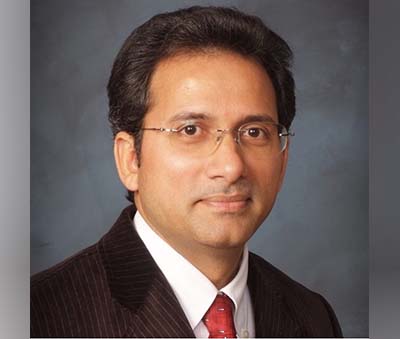 While setting an example and urging others to join him in this noble venture, Dr. Satheesh Kathula himself was present in India in October of this year, and inaugurated the project in Ramaiah Palle village in Mulugu District in the state of Telangana which was sponsored by him.
While setting an example and urging others to join him in this noble venture, Dr. Satheesh Kathula himself was present in India in October of this year, and inaugurated the project in Ramaiah Palle village in Mulugu District in the state of Telangana which was sponsored by him.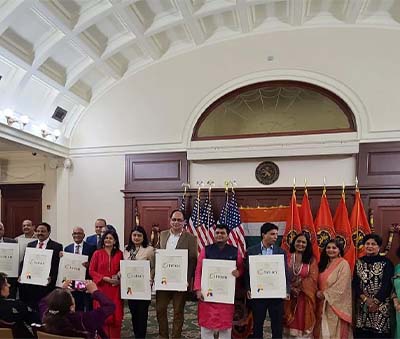 The tireless efforts of the county and founding members along with a dedicated Hosts committee of Dr. Bobby K. Kalotee, Chairperson Indu Jaiswal, Beena Kothari, Flora Parekh, Jasbir (Jay) Singh, Mukesh Modi, Shashi Malik, Sunita Manjrekar, Deepak Bansal, Indu Gajwani, Anju Sharma and several volunteers and supporters, contributed to the success of the event keeping up the spirit of Diwali.
The tireless efforts of the county and founding members along with a dedicated Hosts committee of Dr. Bobby K. Kalotee, Chairperson Indu Jaiswal, Beena Kothari, Flora Parekh, Jasbir (Jay) Singh, Mukesh Modi, Shashi Malik, Sunita Manjrekar, Deepak Bansal, Indu Gajwani, Anju Sharma and several volunteers and supporters, contributed to the success of the event keeping up the spirit of Diwali. “A week from now, on December 9 and 10, the Biden Administration will be hosting the
“A week from now, on December 9 and 10, the Biden Administration will be hosting the 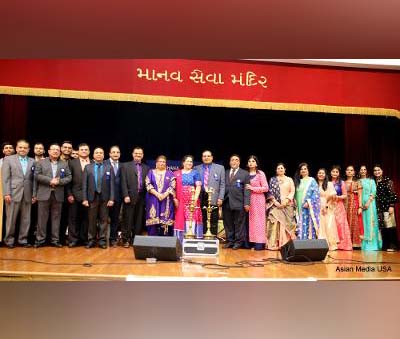 The event started with traditional lamp lighting by the LAGC executive board and other special guests and devotional singing by Rita Shah and chanting by Gina and Suhani. National Anthems were sung by Dhir, Dhruvi, Neil and Nysa. The event was full of musical surprises with beautiful singing by a variety of melodious singers.
The event started with traditional lamp lighting by the LAGC executive board and other special guests and devotional singing by Rita Shah and chanting by Gina and Suhani. National Anthems were sung by Dhir, Dhruvi, Neil and Nysa. The event was full of musical surprises with beautiful singing by a variety of melodious singers.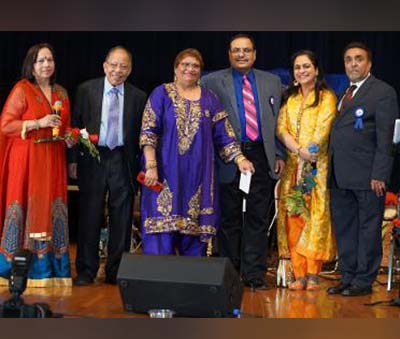 Kirit Thakkar thanked all the guests for attending the events and explained how the association has been working hard to bring the community together. He talked about all the events that LAGC organizes every year.
Kirit Thakkar thanked all the guests for attending the events and explained how the association has been working hard to bring the community together. He talked about all the events that LAGC organizes every year. The host chapter- AAPI-TN presented FFLI with a fundraised $75,000, in order to help strengthen the efforts to end human trafficking and to help continue and expand their impact in India.
The host chapter- AAPI-TN presented FFLI with a fundraised $75,000, in order to help strengthen the efforts to end human trafficking and to help continue and expand their impact in India. The underlying theme of Diwali, celebrating Light over Darkness, Victory of Good over Evil and Knowledge over Ignorance, which has caught up the attention of people all over the world, was done as the traditional lamp was lit by AAPI-TN Executive Committee, AAPI USA President Dr. Anupama Gotimukula, Congressman Jim Cooper and Grand Sponsor Dr. Bharat Sangani.
The underlying theme of Diwali, celebrating Light over Darkness, Victory of Good over Evil and Knowledge over Ignorance, which has caught up the attention of people all over the world, was done as the traditional lamp was lit by AAPI-TN Executive Committee, AAPI USA President Dr. Anupama Gotimukula, Congressman Jim Cooper and Grand Sponsor Dr. Bharat Sangani. Evolving to meet the growing needs of its members and the larger population it is called to serve, AAPI, the largest ethnic physician organization in the United states, representing over 100,000 Indian American Physicians, has grown steadily and is recognized by the authorities, local communities and mainstream media for the many noble initiatives AAPI has led, especially during the Covid pandemic, she said.
Evolving to meet the growing needs of its members and the larger population it is called to serve, AAPI, the largest ethnic physician organization in the United states, representing over 100,000 Indian American Physicians, has grown steadily and is recognized by the authorities, local communities and mainstream media for the many noble initiatives AAPI has led, especially during the Covid pandemic, she said. During the CMEs, several important topics with recent advances were well received by the AAPI fraternity. Themes for the CMEs included: ‘Cancer therapy: Advancement as we head for a cure’ by Dr. Nishitha Reddy, ‘Psychiatric sequelae of human trafficking’ by Dr. Sricharan Moturi, ‘Cardiovascular disease in South Asians- (Masala Study)’ by Dr. Ramya Suryadevara and ‘Stem cell therapy: The future of medicine’ by Dr. Sai Ram Atluri. The CME was well-attended, with active engagement between speakers and moderators (Dr. Amit Keswani, Dr.Varun Dhulipala, Dr. Biliyar, and Dr. Gunuganti. Attendees were eligible for 3 Category 1 CME hours, accredited by the Chicago Medical Society (CMS).
During the CMEs, several important topics with recent advances were well received by the AAPI fraternity. Themes for the CMEs included: ‘Cancer therapy: Advancement as we head for a cure’ by Dr. Nishitha Reddy, ‘Psychiatric sequelae of human trafficking’ by Dr. Sricharan Moturi, ‘Cardiovascular disease in South Asians- (Masala Study)’ by Dr. Ramya Suryadevara and ‘Stem cell therapy: The future of medicine’ by Dr. Sai Ram Atluri. The CME was well-attended, with active engagement between speakers and moderators (Dr. Amit Keswani, Dr.Varun Dhulipala, Dr. Biliyar, and Dr. Gunuganti. Attendees were eligible for 3 Category 1 CME hours, accredited by the Chicago Medical Society (CMS). The gala began with the Event Chair Dr. Sunil Kaza welcoming community members, family, friends, colleagues and sponsors. “We, AAPI- TN team, worked hard to stick to the mission of AAPI, for education and charity to serve humanity. We thank each and every member that attended and supported the event. Our special thanks to all our Sponsors,” said Dr. Sunil Kaza, Chair of the Gala Committee. The Grand sponsor for the event, Dr. Bharat Sangani attended the meeting personally.
The gala began with the Event Chair Dr. Sunil Kaza welcoming community members, family, friends, colleagues and sponsors. “We, AAPI- TN team, worked hard to stick to the mission of AAPI, for education and charity to serve humanity. We thank each and every member that attended and supported the event. Our special thanks to all our Sponsors,” said Dr. Sunil Kaza, Chair of the Gala Committee. The Grand sponsor for the event, Dr. Bharat Sangani attended the meeting personally. Physicians and other health professionals on the front lines of COVID-19 care have experienced so many unknowns during the pandemic. They’ve also put their own health and the well-being of their families on the line to provide care.
Physicians and other health professionals on the front lines of COVID-19 care have experienced so many unknowns during the pandemic. They’ve also put their own health and the well-being of their families on the line to provide care. AAPI’s participation at the Marathon was inspired and sponsored by the Botla Foundation, which provided a great kick start to AAPI’s wellness theme, pointed to the Six Pillars of Lifestyle Medicine: 1. Healthy Diet; 2. Being active; 3. Restorative sleep; 4. Managing stress; 5. Have social and supportive connections; and, 6. Avoiding abusive drugs and habits.
AAPI’s participation at the Marathon was inspired and sponsored by the Botla Foundation, which provided a great kick start to AAPI’s wellness theme, pointed to the Six Pillars of Lifestyle Medicine: 1. Healthy Diet; 2. Being active; 3. Restorative sleep; 4. Managing stress; 5. Have social and supportive connections; and, 6. Avoiding abusive drugs and habits.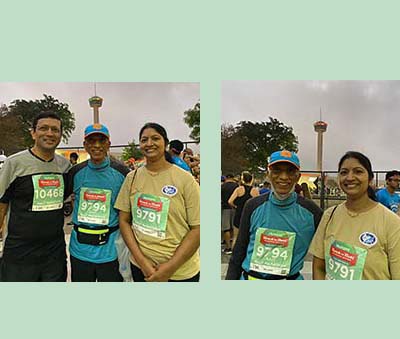 Dozens of Doctors and community leaders joined the Rock and Roll Marathon, which had attracted over 18,000 participants from around the nation, and made this an inspiring experience for all. Dr. Ravi Botla, while thanking and congratulating all the participants at the Marathon, said, “Running with you all is an amazing experience. Several friends made their personal bests today. Hope to continue to do some physical activity (running/walking/cycling) to improve our health. On behalf of all our runners yesterday and today, Botla Foundation will donate $25,000 to AAPI, irrespective of the number of participants. We should be proud of this accomplishment. Thank you Anupama and Jayesh to provide this opportunity.”
Dozens of Doctors and community leaders joined the Rock and Roll Marathon, which had attracted over 18,000 participants from around the nation, and made this an inspiring experience for all. Dr. Ravi Botla, while thanking and congratulating all the participants at the Marathon, said, “Running with you all is an amazing experience. Several friends made their personal bests today. Hope to continue to do some physical activity (running/walking/cycling) to improve our health. On behalf of all our runners yesterday and today, Botla Foundation will donate $25,000 to AAPI, irrespective of the number of participants. We should be proud of this accomplishment. Thank you Anupama and Jayesh to provide this opportunity.” “After a hiatus of 5 years from long distance running, I am thrilled to announce that I completed running the half marathon in San Antonio on a PLANT BASED DIET!” Dr. Akil Taher said. “I ran to support the American Association of Physicians of Indian origin (AAPI) under the leadership of Dr. Anupama Gotimukula ad Dr. Jayesh Shah. AAPI has done some phenomenal charity work here in the US and India. Also a big thank you to the Botla family for their inspirational support to AAPI,” he added.
“After a hiatus of 5 years from long distance running, I am thrilled to announce that I completed running the half marathon in San Antonio on a PLANT BASED DIET!” Dr. Akil Taher said. “I ran to support the American Association of Physicians of Indian origin (AAPI) under the leadership of Dr. Anupama Gotimukula ad Dr. Jayesh Shah. AAPI has done some phenomenal charity work here in the US and India. Also a big thank you to the Botla family for their inspirational support to AAPI,” he added. To run my first half-marathon with my Idol, Dr. Taher. He is a living proof of the power of ‘Whole Foods Plant Based’ Diet and Physical Exercise in not just recovering from a major surgery but healing from within for a better and stronger health than before. His presenceat the Marathon inspired us to sign up for the event and support AAPI in promoting ‘health & fitness’ in our community,” stated Dr. Bhoja R. Katipally.
To run my first half-marathon with my Idol, Dr. Taher. He is a living proof of the power of ‘Whole Foods Plant Based’ Diet and Physical Exercise in not just recovering from a major surgery but healing from within for a better and stronger health than before. His presenceat the Marathon inspired us to sign up for the event and support AAPI in promoting ‘health & fitness’ in our community,” stated Dr. Bhoja R. Katipally. The donor, Dr. Ravi Botla did his first full Marathon. There are several in the group who did their first half marathon including Dr. Jayesh Shah! We thank the Botla Foundation who inspired us! We ran with a good heart to support AAPI. Nothing is impossible if we have the motivation inside us!!” For more details on AAPI and the 40th convention, please visit:
The donor, Dr. Ravi Botla did his first full Marathon. There are several in the group who did their first half marathon including Dr. Jayesh Shah! We thank the Botla Foundation who inspired us! We ran with a good heart to support AAPI. Nothing is impossible if we have the motivation inside us!!” For more details on AAPI and the 40th convention, please visit:  The new data has been welcomed, and is hailed as a heartening signal by government officials and researchers in a country that is expected to overtake China to become the world’s most populous sometime this decade. Since the mid-20th century, Indian leaders have tried to curb high birthrates, which are often reversely correlated with women’s welfare metrics and economic progress. A burgeoning population is seen, in the longer term, as a hurdle to development and a driver of environmental degradation and greenhouse gas emissions.
The new data has been welcomed, and is hailed as a heartening signal by government officials and researchers in a country that is expected to overtake China to become the world’s most populous sometime this decade. Since the mid-20th century, Indian leaders have tried to curb high birthrates, which are often reversely correlated with women’s welfare metrics and economic progress. A burgeoning population is seen, in the longer term, as a hurdle to development and a driver of environmental degradation and greenhouse gas emissions. According to her, “Senior leaders from leading healthcare organizations such as pharmaceuticals, device and medical equipment manufacturers and major medical teaching institutions, hospitals and from the Ministries – Health, External/Overseas Affairs and regulatory bodies are collaborating with AAPI with the ultimate goal to provide access to high quality and affordable healthcare to all people of India.”
According to her, “Senior leaders from leading healthcare organizations such as pharmaceuticals, device and medical equipment manufacturers and major medical teaching institutions, hospitals and from the Ministries – Health, External/Overseas Affairs and regulatory bodies are collaborating with AAPI with the ultimate goal to provide access to high quality and affordable healthcare to all people of India.”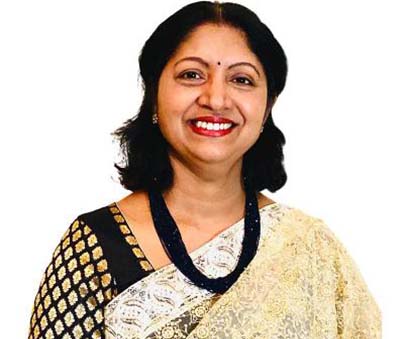 Dr. Joseph Chalil, Chair of the CEO Forum said, “AAPI has made significant contributions towards addressing several issues affecting the healthcare system in India. During the GHS 2022, AAPI at the popular CEO Forum, physician leaders from the United States and India will have an opportunity to brainstorm and explore ways to focus on the theme, “Prevention is Better Than Cure” and recommend possible ways to plan and implement preventive medicine that will save resources and precious human lives.”
Dr. Joseph Chalil, Chair of the CEO Forum said, “AAPI has made significant contributions towards addressing several issues affecting the healthcare system in India. During the GHS 2022, AAPI at the popular CEO Forum, physician leaders from the United States and India will have an opportunity to brainstorm and explore ways to focus on the theme, “Prevention is Better Than Cure” and recommend possible ways to plan and implement preventive medicine that will save resources and precious human lives.”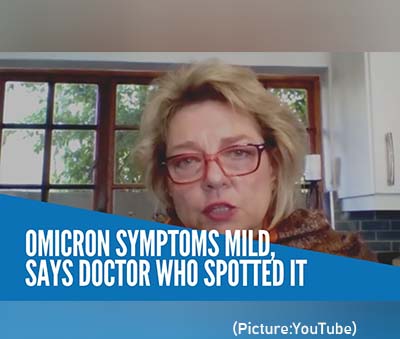 “Their symptoms were so different and so mild from those I had treated before,” said Dr Coetzee, a GP for 33 years who chairs the South African Medical Association alongside running her practice.
“Their symptoms were so different and so mild from those I had treated before,” said Dr Coetzee, a GP for 33 years who chairs the South African Medical Association alongside running her practice. FIA’s General Secretary Richa Chand conducted the proceedings of the Annual Board Meeting for the year 2021-2022 and invited Founder President Sunil Shah for his opening remarks. Shah in his speech, outlined the successes behind the year 2021, listing the events conducted by the FIA and its team. He thanked the outgoing team for its hard work in putting together and conducting various India centric and Charitable events during the year. He also took the opportunity to welcome new members to team FIA. In a major announcement he declared that FIA would initiate an annual FIA Scholarship for deserving students starting from the year 2022.
FIA’s General Secretary Richa Chand conducted the proceedings of the Annual Board Meeting for the year 2021-2022 and invited Founder President Sunil Shah for his opening remarks. Shah in his speech, outlined the successes behind the year 2021, listing the events conducted by the FIA and its team. He thanked the outgoing team for its hard work in putting together and conducting various India centric and Charitable events during the year. He also took the opportunity to welcome new members to team FIA. In a major announcement he declared that FIA would initiate an annual FIA Scholarship for deserving students starting from the year 2022. Mr Chouksey’s replica – nestled deep inside his sprawling 50-acre property, which includes a hospital, has also been attracting a steady stream of visitors.
Mr Chouksey’s replica – nestled deep inside his sprawling 50-acre property, which includes a hospital, has also been attracting a steady stream of visitors.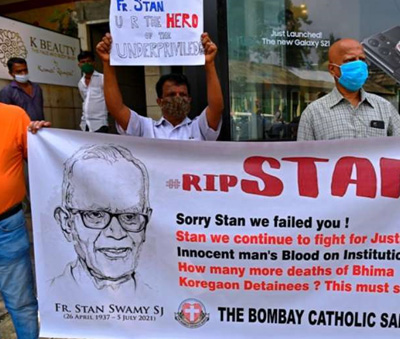 The 84-year-old Jesuit was arrested on Oct. 8, 2020, by the National Investigation Agency (NIA), a federal anti-terror combat unit, from his residence on the outskirts of Jharkhand’s state capital Ranchi in eastern India.
The 84-year-old Jesuit was arrested on Oct. 8, 2020, by the National Investigation Agency (NIA), a federal anti-terror combat unit, from his residence on the outskirts of Jharkhand’s state capital Ranchi in eastern India.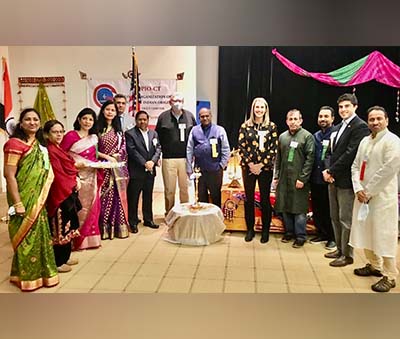 The launch event began with an invocation to Lord Ganesha by Prachi, which was followed by the lighting of the traditional lamp and diyas by dignitaries and GOPIO leaders, signifying the Diwali celebration. In her welcome address, Library President Alice Knapp lauded the new initiative from the GOPIO-CT and thanked the Indian Consulate for donating the books.
The launch event began with an invocation to Lord Ganesha by Prachi, which was followed by the lighting of the traditional lamp and diyas by dignitaries and GOPIO leaders, signifying the Diwali celebration. In her welcome address, Library President Alice Knapp lauded the new initiative from the GOPIO-CT and thanked the Indian Consulate for donating the books. Stating that the sharing of knowledge and discovery have shaped the destiny of the humanity since beginning of the world, Consul General Randhir Jaiswal pointed out as to how in 1960s, India has gained sufficiency in food production by sharing of knowledge by the United States that led to Green revolution in India. “And we are ever grateful to the United States for sharing of knowledge and for the friendship and collaboration between the two nations, which is the defining moment of the 21st century.”
Stating that the sharing of knowledge and discovery have shaped the destiny of the humanity since beginning of the world, Consul General Randhir Jaiswal pointed out as to how in 1960s, India has gained sufficiency in food production by sharing of knowledge by the United States that led to Green revolution in India. “And we are ever grateful to the United States for sharing of knowledge and for the friendship and collaboration between the two nations, which is the defining moment of the 21st century.” CT State Representative, Matt Blumenthal in his felicitation address, “This has ben tryting times for the whole world. GOPIO has played a critical role in our state to help face and overcome the challenges. I am grateful to the Indian American community for your great contributions and making our state stronger and dynamic.”
CT State Representative, Matt Blumenthal in his felicitation address, “This has ben tryting times for the whole world. GOPIO has played a critical role in our state to help face and overcome the challenges. I am grateful to the Indian American community for your great contributions and making our state stronger and dynamic.”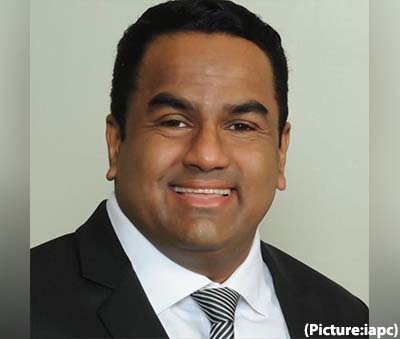 The World Health Organization says that cancer is diagnosed in more than 14 million people worldwide annually and ends up killing approximately 8.8 million. What is most shocking is that two-thirds of these deaths are in low-middle income countries where diagnosis is found to be inadequate.
The World Health Organization says that cancer is diagnosed in more than 14 million people worldwide annually and ends up killing approximately 8.8 million. What is most shocking is that two-thirds of these deaths are in low-middle income countries where diagnosis is found to be inadequate. The annual physical exam is part of the larger discussion about primary care and whether it is necessary. In the U.S., India, and other countries around the world, medicine has become the way you manage disease, not prevent it. Primary care, on the other hand, is a way to prevent disease by talking with patients about their potential health risks and giving them practical advice on how to care for their health, while considering their unique lifestyle challenges.
The annual physical exam is part of the larger discussion about primary care and whether it is necessary. In the U.S., India, and other countries around the world, medicine has become the way you manage disease, not prevent it. Primary care, on the other hand, is a way to prevent disease by talking with patients about their potential health risks and giving them practical advice on how to care for their health, while considering their unique lifestyle challenges. Others who were honored included: Mary Philip, who was a Lieutenant in the Indian Defense Force and a past President of the Indian Nurses Association of New York was honored for notable contributions in Nursing and Community Service; and Nandini P. Nair, Esq, who is a partner and co-chair of the Immigration and Naturalization practice group and serves on the Management Committee at Greenspoon Marder LLP was honored for notable services and achievements in Legal Services. Dr. Sabu Varghese and Dr. Blessy Mary Joseph, practicing physicians in New York were honored with Special Award for notable services during the Pandemic in 2020 and 2021.
Others who were honored included: Mary Philip, who was a Lieutenant in the Indian Defense Force and a past President of the Indian Nurses Association of New York was honored for notable contributions in Nursing and Community Service; and Nandini P. Nair, Esq, who is a partner and co-chair of the Immigration and Naturalization practice group and serves on the Management Committee at Greenspoon Marder LLP was honored for notable services and achievements in Legal Services. Dr. Sabu Varghese and Dr. Blessy Mary Joseph, practicing physicians in New York were honored with Special Award for notable services during the Pandemic in 2020 and 2021.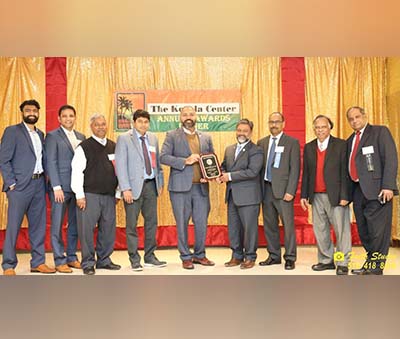 Dr. George Abraham, who was also an awardee, was the keynote speaker. In his keynote speech, Dr. Abraham implored that we should strive to move forward by including everyone and treating everybody equally, and it is the duty of the leaders to make sure that this is happening. An organization gets much more strength when it becomes a melting pot of people and ideas, he concluded. Dr. George Abraham was introduced by Dr. Thomas Abraham, Chairman of the Trustee Board and Award Committee member and Consul A.K. Vijayakrishnan presented the award. Dr. Thomas Abraham also explained the process of selecting the awardees.
Dr. George Abraham, who was also an awardee, was the keynote speaker. In his keynote speech, Dr. Abraham implored that we should strive to move forward by including everyone and treating everybody equally, and it is the duty of the leaders to make sure that this is happening. An organization gets much more strength when it becomes a melting pot of people and ideas, he concluded. Dr. George Abraham was introduced by Dr. Thomas Abraham, Chairman of the Trustee Board and Award Committee member and Consul A.K. Vijayakrishnan presented the award. Dr. Thomas Abraham also explained the process of selecting the awardees. The award for performing Arts went to Chandrika Kurup. In her speech, Mrs. Kurup expressed a lot of satisfaction that her students are now running their own successful dance schools and other related artist works here in America and in Kerala. Chandrika was introduced by Annie Esthappan, one of the youth representatives of the Kerala Center and former student of Mrs. Kurup, and Abraham Philip, CPA, presented the award.
The award for performing Arts went to Chandrika Kurup. In her speech, Mrs. Kurup expressed a lot of satisfaction that her students are now running their own successful dance schools and other related artist works here in America and in Kerala. Chandrika was introduced by Annie Esthappan, one of the youth representatives of the Kerala Center and former student of Mrs. Kurup, and Abraham Philip, CPA, presented the award.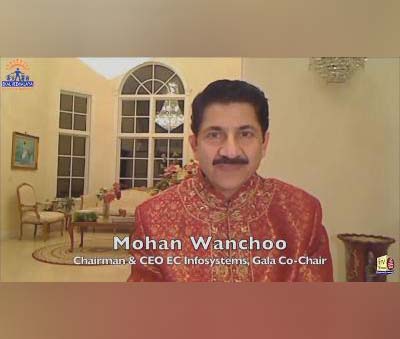 This two-hour event, co-chaired by Mohan Wanchoo and Kamlesh Shah, both successful entrepreneurs and philanthropist, saw consistent overwhelming response from the donors, from the moment it opened up till it was capped by youthful entertainment by “Penn-Masala’, a youthful group of famous singers from “University of Pennsylvania”.
This two-hour event, co-chaired by Mohan Wanchoo and Kamlesh Shah, both successful entrepreneurs and philanthropist, saw consistent overwhelming response from the donors, from the moment it opened up till it was capped by youthful entertainment by “Penn-Masala’, a youthful group of famous singers from “University of Pennsylvania”.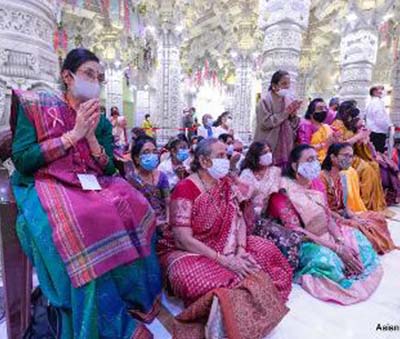 The celebrations offered attendees an opportunity for darshan of the annakut and divine murtis of God while arti and thaal were sung throughout the day. Visitors were also inspired through an exhibition on with informational posters and decorations describing different traditions and stories behind the multi-day festival. In expressing the warmth and goodwill of Diwali, prasad in the form of sweets was distributed to all those joining in the celebrations. The festivities were open to all members of the local community.
The celebrations offered attendees an opportunity for darshan of the annakut and divine murtis of God while arti and thaal were sung throughout the day. Visitors were also inspired through an exhibition on with informational posters and decorations describing different traditions and stories behind the multi-day festival. In expressing the warmth and goodwill of Diwali, prasad in the form of sweets was distributed to all those joining in the celebrations. The festivities were open to all members of the local community.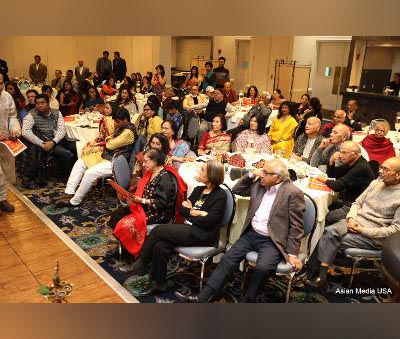 The event started with a Diya lighting ceremony by executive committee and board of trustees members led by Dr. Subhash Pandey and Chief Guest, Mr. PK Mishra, and was followed by a beautiful sitar instrumental presentation of bhajan medley by Mr. Paneesh Rao. The program was organized and coordinated by Mr. Sunish Mittal and Mr. Raj Kumar Upadhyay, treasurer and president of the UP Association, respectively.
The event started with a Diya lighting ceremony by executive committee and board of trustees members led by Dr. Subhash Pandey and Chief Guest, Mr. PK Mishra, and was followed by a beautiful sitar instrumental presentation of bhajan medley by Mr. Paneesh Rao. The program was organized and coordinated by Mr. Sunish Mittal and Mr. Raj Kumar Upadhyay, treasurer and president of the UP Association, respectively.  The Association brought in several renowned artists from Chicago who presented a range of traditional, modern, and contemporary Indian performances, including an outstanding dance (Ganesh Vandana and Shri Ram stuti) by Mrs. Gauri Jog, director & teacher, India dance school. This was followed by several melodious songs by two well-known singers, Mrs. Ananya Ghosh and Mr. Sreepathy that were accompanied by an outstanding musician team. This was followed by a program called “Saaz aur Alfaaz” by Mr. Rakesh Malhotra, a famous poet, and Mr. Sunish Mittal, a well accomplished singer. Two children’s performers, Mr. Shlok Jaiswal and Ms. Anavi Ghosh also sang melodious songs for this occasion. The program ended with a presentation of a colorful group dance to a Bollywood movie song.
The Association brought in several renowned artists from Chicago who presented a range of traditional, modern, and contemporary Indian performances, including an outstanding dance (Ganesh Vandana and Shri Ram stuti) by Mrs. Gauri Jog, director & teacher, India dance school. This was followed by several melodious songs by two well-known singers, Mrs. Ananya Ghosh and Mr. Sreepathy that were accompanied by an outstanding musician team. This was followed by a program called “Saaz aur Alfaaz” by Mr. Rakesh Malhotra, a famous poet, and Mr. Sunish Mittal, a well accomplished singer. Two children’s performers, Mr. Shlok Jaiswal and Ms. Anavi Ghosh also sang melodious songs for this occasion. The program ended with a presentation of a colorful group dance to a Bollywood movie song.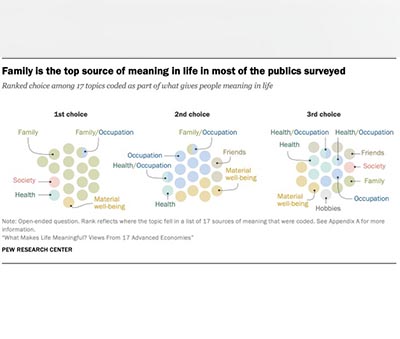


 Younger people tend to emphasize their friends, education and hobbies as sources of meaning more so than older people. For their part, older people are more likely to discuss retirement and health than younger ones. Older people are also somewhat more likely to discuss challenges and negative things when discussing what gives them meaning than younger ones.
Younger people tend to emphasize their friends, education and hobbies as sources of meaning more so than older people. For their part, older people are more likely to discuss retirement and health than younger ones. Older people are also somewhat more likely to discuss challenges and negative things when discussing what gives them meaning than younger ones.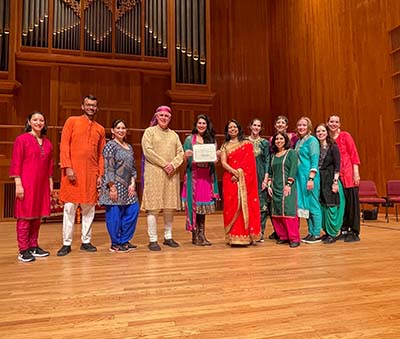 Diwali – known as the festival of lights – is one of the major festivals celebrated by Hindus, Jains, Sikhs and even some Buddhists. Each religion has its own historical narrative behind the holiday. Diwali is widely observed among more than a billion people from a variety of faiths across India and its diaspora. The five days of Diwali are marked by prayer, feasts, fireworks, family gatherings, and charitable giving.
Diwali – known as the festival of lights – is one of the major festivals celebrated by Hindus, Jains, Sikhs and even some Buddhists. Each religion has its own historical narrative behind the holiday. Diwali is widely observed among more than a billion people from a variety of faiths across India and its diaspora. The five days of Diwali are marked by prayer, feasts, fireworks, family gatherings, and charitable giving.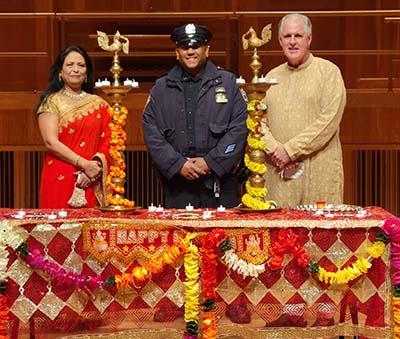 “May the lamps (Diya) of Diwali (Deepavali) illuminate everyone’s life with happiness, peace and good health. Wish you and your family a very prosperous Diwali and a happy new year! On this Diwali, let’s make a promise to bring lights in people lives who suffered during this pandemic, and also pray to God for a good health and fortune for everyone! Looking forward to celebrate Diwali back again at City Hall next year with more joy of having it as NYC public school’s holiday!,” said Dr. Neeta Jain District Leader and co-organizer.
“May the lamps (Diya) of Diwali (Deepavali) illuminate everyone’s life with happiness, peace and good health. Wish you and your family a very prosperous Diwali and a happy new year! On this Diwali, let’s make a promise to bring lights in people lives who suffered during this pandemic, and also pray to God for a good health and fortune for everyone! Looking forward to celebrate Diwali back again at City Hall next year with more joy of having it as NYC public school’s holiday!,” said Dr. Neeta Jain District Leader and co-organizer. “New York is no stranger to Diwali and its symbolic relevance. It is very heartening to see the festival of lights being celebrated here with great joy and fervor – not only by the South-Asian community, but also by members of diverse ethnicities and nationalities just like the Indian-American community celebrates Christmas and other festivals passionately and with great merriments,” said Deputy Consul General of India, Dr. Varun Jeph, who was in attendance at Saturday’s festival. “It truly reflects the American and Indian values of celebrating diversity and of embracing different cultures. May the festival of lights bring joy, love, peace, prosperity and good health to everyone.”
“New York is no stranger to Diwali and its symbolic relevance. It is very heartening to see the festival of lights being celebrated here with great joy and fervor – not only by the South-Asian community, but also by members of diverse ethnicities and nationalities just like the Indian-American community celebrates Christmas and other festivals passionately and with great merriments,” said Deputy Consul General of India, Dr. Varun Jeph, who was in attendance at Saturday’s festival. “It truly reflects the American and Indian values of celebrating diversity and of embracing different cultures. May the festival of lights bring joy, love, peace, prosperity and good health to everyone.”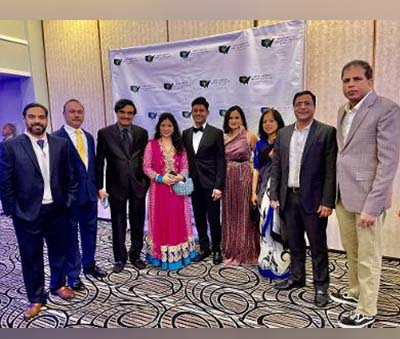 “As the President, one of my main goal is to revitalize local Chapters that are the backbone for the national organization; help make the local Chapters financially viable as funds have dwindled due to pharma support; and to bring in younger physicians into the fold,” the young and dynamic President told a select group of audience who had come to cheer him and the new executive committee.
“As the President, one of my main goal is to revitalize local Chapters that are the backbone for the national organization; help make the local Chapters financially viable as funds have dwindled due to pharma support; and to bring in younger physicians into the fold,” the young and dynamic President told a select group of audience who had come to cheer him and the new executive committee.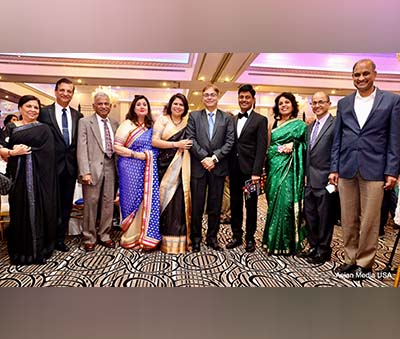 “I would also like to thank all the leaders of IAMA, especially Drs, Vemuri Murthy, Hanumadass, Rohit Vasa, Satya Ahuja, Shastri Swaminathan, Khandelwal, Arvind Goyal, Annita John, Utpal Parikh, Sukanya Reddy and several others.” He had a special note for Dr. Lalmalani. “I would like to thank my spiritual guru and political mentor, our Mayor of Oak Brook Dr. Lalmalani.”
“I would also like to thank all the leaders of IAMA, especially Drs, Vemuri Murthy, Hanumadass, Rohit Vasa, Satya Ahuja, Shastri Swaminathan, Khandelwal, Arvind Goyal, Annita John, Utpal Parikh, Sukanya Reddy and several others.” He had a special note for Dr. Lalmalani. “I would like to thank my spiritual guru and political mentor, our Mayor of Oak Brook Dr. Lalmalani.” Author of many international medical journal articles, Dr. Reddy has traveled extensively, giving specialty lectures on the complex procedures that he does. Active in teaching and mentoring many medical students and residents, Dr. Reddy has received numerous teaching and mentoring awards. To his credit, he is a four-time recipient of “Faculty award for excellence in teaching” awarded by the Harvard Medical Students and Residents.
Author of many international medical journal articles, Dr. Reddy has traveled extensively, giving specialty lectures on the complex procedures that he does. Active in teaching and mentoring many medical students and residents, Dr. Reddy has received numerous teaching and mentoring awards. To his credit, he is a four-time recipient of “Faculty award for excellence in teaching” awarded by the Harvard Medical Students and Residents. In the summer of 2019, Dr. Reddy organized The Global Health Summit in Hyderabad, an educational event with numerous workshops. Vice President of India, Sri Venkaiah Naidu, Union Minster of Health, Dr. Harshvardhan, both addressed the highly successful Global Health Summit. In October of 2019, he played a key role along with the Indian Resuscitation Council to train almost 500,000 lay people in Cardio-Pulmonary Resuscitation in India.
In the summer of 2019, Dr. Reddy organized The Global Health Summit in Hyderabad, an educational event with numerous workshops. Vice President of India, Sri Venkaiah Naidu, Union Minster of Health, Dr. Harshvardhan, both addressed the highly successful Global Health Summit. In October of 2019, he played a key role along with the Indian Resuscitation Council to train almost 500,000 lay people in Cardio-Pulmonary Resuscitation in India. His leadership and foresight were deeply appreciated as AAPI became the first major organization to call for universal masking. In this regard, AAPI provided free masks to thousands of health care workers. AAPI members have honored more than 10,000 nurses in over 100 hospitals across more than 40 states by sponsoring lunches for them during the Nurses Week. He was instrumental in organizing the Obesity prevention programs in all continenets, sharing medical knowledge globally, team-building activities such as the Share-A-Blanket program, medical education programs such as CPR training, morale building programs like mentoring a future medical students, and India heritage programs like Independence Day celebrations.
His leadership and foresight were deeply appreciated as AAPI became the first major organization to call for universal masking. In this regard, AAPI provided free masks to thousands of health care workers. AAPI members have honored more than 10,000 nurses in over 100 hospitals across more than 40 states by sponsoring lunches for them during the Nurses Week. He was instrumental in organizing the Obesity prevention programs in all continenets, sharing medical knowledge globally, team-building activities such as the Share-A-Blanket program, medical education programs such as CPR training, morale building programs like mentoring a future medical students, and India heritage programs like Independence Day celebrations. IAMA-IL is a non-profit organization comprised of Illinois physicians, fellows, residents, and medical students of Indian origin who are committed to professional excellence and quality patient care. IAMA-IL offers many opportunities for your organization to begin and grow a connection with our members and the communities we serve. We like to partner with organizations and people that strive for similar goals including a commitment to excellence, education, research and serving the community.
IAMA-IL is a non-profit organization comprised of Illinois physicians, fellows, residents, and medical students of Indian origin who are committed to professional excellence and quality patient care. IAMA-IL offers many opportunities for your organization to begin and grow a connection with our members and the communities we serve. We like to partner with organizations and people that strive for similar goals including a commitment to excellence, education, research and serving the community.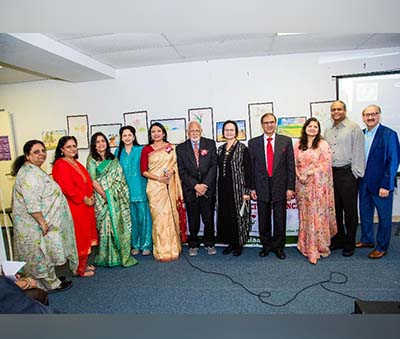 Dr. Vasundhara Kalasapudi, who is the founder of India Home nonprofit organization and a current board member of NIAASC hosted the conference, which was informative and entertaining with vegan breakfast and lunch served. Dr. Bhavani Srinivasan, Vice president – NIAASC was the coordinator of the conference and coordinated the event effectively and flawlessly.
Dr. Vasundhara Kalasapudi, who is the founder of India Home nonprofit organization and a current board member of NIAASC hosted the conference, which was informative and entertaining with vegan breakfast and lunch served. Dr. Bhavani Srinivasan, Vice president – NIAASC was the coordinator of the conference and coordinated the event effectively and flawlessly.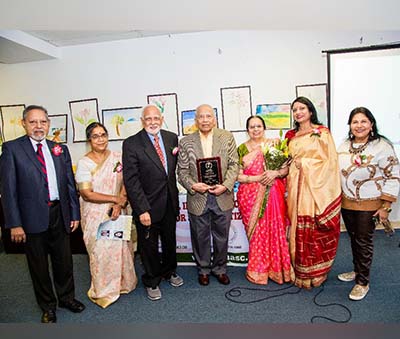 The main speaker was Dr. Vikas Malik, a board-certified medical professional in both Child-Adolescent Psychiatry and Adult Psychiatry and his PowerPoint presentation on Mental Health in light of COVID-19 captivated the audience of roughly 70 physical attendees and 30 virtual attendees, who appreciated the information and knowledge that was succinctly explained. His presentation was followed by Dr. Swaminathan Giridharan, a Geriatric specialist, who spoke about COVID-19 Vaccination. The conference also focused on physical health and a presentation by Mrs. Suman Munjal, president of World Vegan Vision, who discussed the health benefits pertaining to a vegan diet.
The main speaker was Dr. Vikas Malik, a board-certified medical professional in both Child-Adolescent Psychiatry and Adult Psychiatry and his PowerPoint presentation on Mental Health in light of COVID-19 captivated the audience of roughly 70 physical attendees and 30 virtual attendees, who appreciated the information and knowledge that was succinctly explained. His presentation was followed by Dr. Swaminathan Giridharan, a Geriatric specialist, who spoke about COVID-19 Vaccination. The conference also focused on physical health and a presentation by Mrs. Suman Munjal, president of World Vegan Vision, who discussed the health benefits pertaining to a vegan diet. Lunch was followed by Diwali cultural program that was presented by Ms. Jyoti Gupta and her team consisted of several singers, Dr.Jag Kalra, Kul Bhooshan Sharma, Gautam Chopra and Raj Dhingra. The group entertained and regaled the audience with lively Bollywood songs. Music program was followed by Diwali Felicitation by Nilima Madan.
Lunch was followed by Diwali cultural program that was presented by Ms. Jyoti Gupta and her team consisted of several singers, Dr.Jag Kalra, Kul Bhooshan Sharma, Gautam Chopra and Raj Dhingra. The group entertained and regaled the audience with lively Bollywood songs. Music program was followed by Diwali Felicitation by Nilima Madan. Shekar Krishnan and Shahana Hanif made history election night this year, becoming the first ever South Asian Americans ever been elected to New York City Council.
Shekar Krishnan and Shahana Hanif made history election night this year, becoming the first ever South Asian Americans ever been elected to New York City Council. 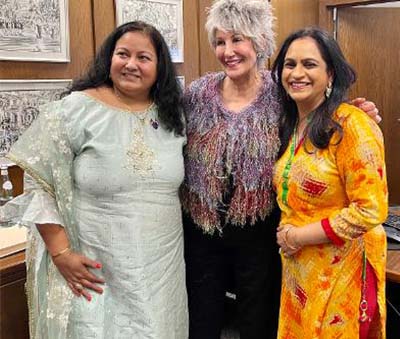 Lion Hina Trivedi spoke about the selfless efforts by Chicago Indo Us lions club in helping families and kids by donating school supplies, backpacks, coat drive and food drive. The club recently helped many patients in India with ventilators as well.
Lion Hina Trivedi spoke about the selfless efforts by Chicago Indo Us lions club in helping families and kids by donating school supplies, backpacks, coat drive and food drive. The club recently helped many patients in India with ventilators as well.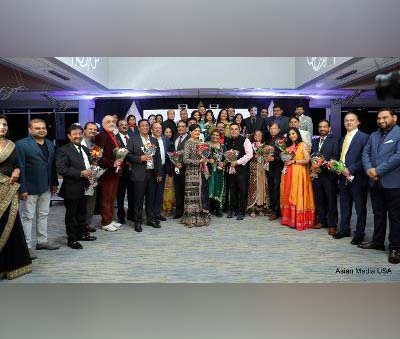 The event featured some very well-known vocalists of Chicagoland Rita Shah, Rajesh Chelam, Jitendra Bulsara, Pratibha Jairath and Mir Ali along with the live orchestra by Orchestra Sa Re Ga Ma led by Hitesh Master Nayak and his team accompanied by Nupur Sound. The musical team kept the guests entertained with a beautiful line up of evergreen melodies. The guests celebrated Sunil Shah’s birthday with a surprise cake cutting ceremony organized by daughter in law Nikki Shah. Mr Shah brought the entire audience on the floor with his excellent singing performance. Sunil and Rita were accompanied by their family and friends who wholeheartedly worked towards the cause behind the evening.
The event featured some very well-known vocalists of Chicagoland Rita Shah, Rajesh Chelam, Jitendra Bulsara, Pratibha Jairath and Mir Ali along with the live orchestra by Orchestra Sa Re Ga Ma led by Hitesh Master Nayak and his team accompanied by Nupur Sound. The musical team kept the guests entertained with a beautiful line up of evergreen melodies. The guests celebrated Sunil Shah’s birthday with a surprise cake cutting ceremony organized by daughter in law Nikki Shah. Mr Shah brought the entire audience on the floor with his excellent singing performance. Sunil and Rita were accompanied by their family and friends who wholeheartedly worked towards the cause behind the evening.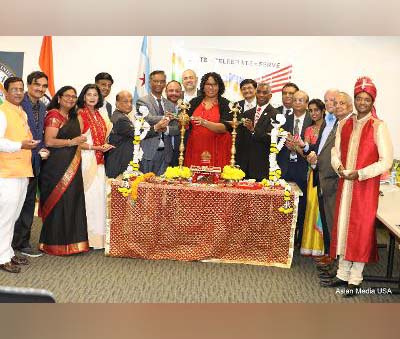 The celebrations encompassed the ceremonious crowning of Chicago’s City Treasurer Hon. Melissa Conyears-Ervin with a silk colorful headgear symbolizing the crowning appreciation from NCAIA for hosting a grand Diwali in the magnificent iconic City Hall building that was led by Event Convener & Vice President Ajeet Singh joined by NCAIA officers: Harish Kolasani, Dr. Suresh Reddy, Vinesh Virani, Neelam Dwivedi Singh, Keerthi Kumar Ravoori, Shekhar Misra, Iftekhar Shareef & Nag Jaiswal. NCAIA National President Harish Kolasani welcomed the guests and outlined the mission of National Council of Asian Indian Associations and how it impacted lives especially in recent times contributing towards the goal of eradication of the pandemic.
The celebrations encompassed the ceremonious crowning of Chicago’s City Treasurer Hon. Melissa Conyears-Ervin with a silk colorful headgear symbolizing the crowning appreciation from NCAIA for hosting a grand Diwali in the magnificent iconic City Hall building that was led by Event Convener & Vice President Ajeet Singh joined by NCAIA officers: Harish Kolasani, Dr. Suresh Reddy, Vinesh Virani, Neelam Dwivedi Singh, Keerthi Kumar Ravoori, Shekhar Misra, Iftekhar Shareef & Nag Jaiswal. NCAIA National President Harish Kolasani welcomed the guests and outlined the mission of National Council of Asian Indian Associations and how it impacted lives especially in recent times contributing towards the goal of eradication of the pandemic.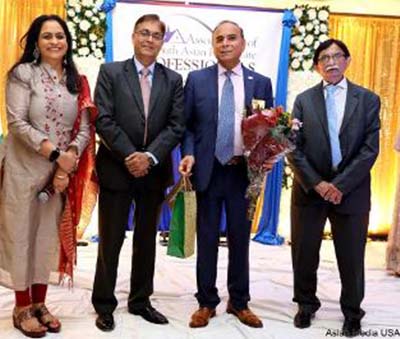 The gala had a variety dance performance by very well-known artists from Chicagoland that included Chicago Kala Kshetra, Sonali Shani and Rewa Shani, Swati Pandey, Aanya and Usha Kabra.
The gala had a variety dance performance by very well-known artists from Chicagoland that included Chicago Kala Kshetra, Sonali Shani and Rewa Shani, Swati Pandey, Aanya and Usha Kabra.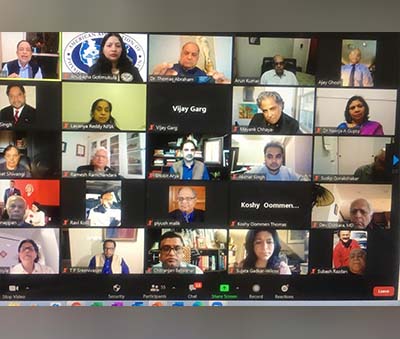 The book was released by New Delhi-based publisher Wisdom Tree and is available in the U.S. via Amazon. Describing the book as an “eclectic amalgam of perspectives on the emerging Indian-American story,” Tarun Basu said, “This evocative collection—of the kind perhaps not attempted before—captures the rise of Indian-Americans across domains, by exceptional achievers themselves, like Shashi Tharoor, the ones who have been and continue to be a part of the “rise,” like MR Rangaswami and Deepak Raj, top Indian diplomats like TP Sreenivasan and Arun K Singh, scholars like Pradeep K Khosla and Maina Chawla Singh, and others who were part of, associated with, or keenly followed their stories.”
The book was released by New Delhi-based publisher Wisdom Tree and is available in the U.S. via Amazon. Describing the book as an “eclectic amalgam of perspectives on the emerging Indian-American story,” Tarun Basu said, “This evocative collection—of the kind perhaps not attempted before—captures the rise of Indian-Americans across domains, by exceptional achievers themselves, like Shashi Tharoor, the ones who have been and continue to be a part of the “rise,” like MR Rangaswami and Deepak Raj, top Indian diplomats like TP Sreenivasan and Arun K Singh, scholars like Pradeep K Khosla and Maina Chawla Singh, and others who were part of, associated with, or keenly followed their stories.” Unsurprisingly, California continued to provide the bulk of the country’s most expensive zip codes: The Golden State originated 70% of all of the zip codes on this list, including six of the top 10 priciest. And, as usual, New York came in second, providing 17 zip codes in our ranking.
Unsurprisingly, California continued to provide the bulk of the country’s most expensive zip codes: The Golden State originated 70% of all of the zip codes on this list, including six of the top 10 priciest. And, as usual, New York came in second, providing 17 zip codes in our ranking. The U.S. residential market’s vertical price trends were evident among the country’s top zip codes as well, with 92 zips registering price gains — including 23 where the median surged by more than 25%. Conversely, only 12 locations among the priciest registered drops in their medians this year – by comparison, 2020 brought median increases to 78 zips and drops to 23 locations.
The U.S. residential market’s vertical price trends were evident among the country’s top zip codes as well, with 92 zips registering price gains — including 23 where the median surged by more than 25%. Conversely, only 12 locations among the priciest registered drops in their medians this year – by comparison, 2020 brought median increases to 78 zips and drops to 23 locations.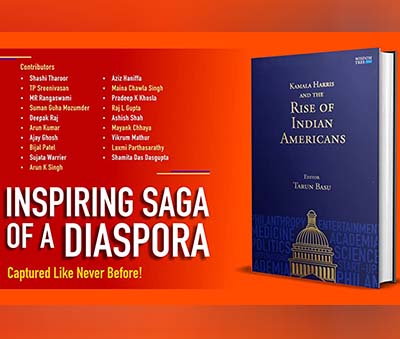 Edited by the Delhi-based veteran journalist and foreign policy analyst, Tarun Basu, the evocative collection titled, “Kamala Harris and the Rise of Indian Americans,” captures the rise of the Indians in the US across domains by exceptional achievers. Sixteen eminent journalists, business leaders and scholars have contributed essays to the timely and priceless volume, which charts the community’s growing and influential political engagement.
Edited by the Delhi-based veteran journalist and foreign policy analyst, Tarun Basu, the evocative collection titled, “Kamala Harris and the Rise of Indian Americans,” captures the rise of the Indians in the US across domains by exceptional achievers. Sixteen eminent journalists, business leaders and scholars have contributed essays to the timely and priceless volume, which charts the community’s growing and influential political engagement. While acknowledging the success story of Indian American physicians, Dr. Anupama Gotimukula, President of AAPI said, “The success story of Indian American Doctors has been arduous. As Ajay Ghosh, who has been working for AAPI for nearly a decade has aptly summarized this long and difficult journey: “While Indian American physicians play a critical role, serving millions of patients in the United States, leading the policies and programs that impact the lives of millions today, it has been a long and arduous journey of struggles and hard work to be on the top of the pyramid.”
While acknowledging the success story of Indian American physicians, Dr. Anupama Gotimukula, President of AAPI said, “The success story of Indian American Doctors has been arduous. As Ajay Ghosh, who has been working for AAPI for nearly a decade has aptly summarized this long and difficult journey: “While Indian American physicians play a critical role, serving millions of patients in the United States, leading the policies and programs that impact the lives of millions today, it has been a long and arduous journey of struggles and hard work to be on the top of the pyramid.”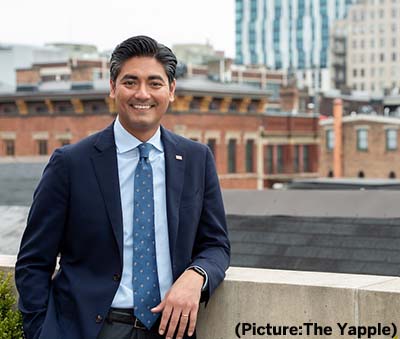 Joshi had 10,930 votes, while Hahn had 9,459 and Makropoulos, 301. The race was to replace Democratic Mayor Thomas Lankey whose term ends Dec. 31. Lankey did not seek reelection.
Joshi had 10,930 votes, while Hahn had 9,459 and Makropoulos, 301. The race was to replace Democratic Mayor Thomas Lankey whose term ends Dec. 31. Lankey did not seek reelection.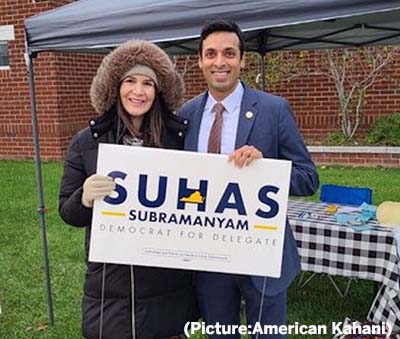 Republicans won 50 seats Nov. 2 in Virginia’s House of Delegates, while Democrats won 40, for a 55-45 Republican majority overall at the statehouse. In one of the most-watched races of the evening, Youngkin beat former Virginia Governor Terry McAuliffe, a Democrat. Virginia has traditionally been considered a solidly blue state.
Republicans won 50 seats Nov. 2 in Virginia’s House of Delegates, while Democrats won 40, for a 55-45 Republican majority overall at the statehouse. In one of the most-watched races of the evening, Youngkin beat former Virginia Governor Terry McAuliffe, a Democrat. Virginia has traditionally been considered a solidly blue state.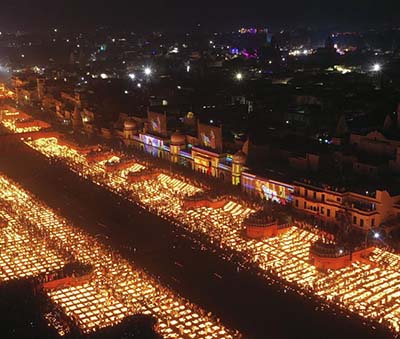 Indians across the country began celebrating Diwali, the Hindu festival of lights, the triumphant return of Lord ram to Ayodhya after rescuing Sita from Sri Lanka. Diwali is typically celebrated by socializing and exchanging gifts with family and friends. Many light oil lamps or candles to symbolize a victory of light over darkness, and fireworks are set off as part of the celebrations.
Indians across the country began celebrating Diwali, the Hindu festival of lights, the triumphant return of Lord ram to Ayodhya after rescuing Sita from Sri Lanka. Diwali is typically celebrated by socializing and exchanging gifts with family and friends. Many light oil lamps or candles to symbolize a victory of light over darkness, and fireworks are set off as part of the celebrations. The President of EventGuru Inc. Neeta Bhasin said ‘We are sharing the message of Deepavali – Knowledge over Ignorance, Light over Darkness, Peace, Love, Unity and Togetherness and inclusion in diversity to the World from the biggest crossroads of the world, Times Square. Even the universe responded in appreciation by keeping the weather conducive to the event despite forecasts of rain throughout the day.’
The President of EventGuru Inc. Neeta Bhasin said ‘We are sharing the message of Deepavali – Knowledge over Ignorance, Light over Darkness, Peace, Love, Unity and Togetherness and inclusion in diversity to the World from the biggest crossroads of the world, Times Square. Even the universe responded in appreciation by keeping the weather conducive to the event despite forecasts of rain throughout the day.’ This was followed by the dignitaries speaking on the Times Square stage which included some of the most affluent people of New York. List of speakers included Consulate General of India in New York, Randhir Jaiswal, New York State Governor Kathleen Courtney Hochul U.S. Senator Charles Ellis “Chuck” Schumer, U.S. Rep. Carolyn Maloney (D-NY), NY State Senator John Liu, Gajendra Suri and Beena Kothari from Samman for All , ShopRite’s Ranjana Choudhry, Thomas Rajan from American Airlines, Harry Singh Bolla of Bolla Oil Corp, Padma Shri Mr. H R Shah – Chairman of TV Asia and other sponsors of the festival.
This was followed by the dignitaries speaking on the Times Square stage which included some of the most affluent people of New York. List of speakers included Consulate General of India in New York, Randhir Jaiswal, New York State Governor Kathleen Courtney Hochul U.S. Senator Charles Ellis “Chuck” Schumer, U.S. Rep. Carolyn Maloney (D-NY), NY State Senator John Liu, Gajendra Suri and Beena Kothari from Samman for All , ShopRite’s Ranjana Choudhry, Thomas Rajan from American Airlines, Harry Singh Bolla of Bolla Oil Corp, Padma Shri Mr. H R Shah – Chairman of TV Asia and other sponsors of the festival. NY State Senator, John Liu was very excited to see the huge crowd at Times Square ‘It is great to see everybody in person. No better place to celebrate Diwali than the crossroads of the world right here in Times Square, NY City. With Neeta’s advocacy and esteem journalism and many others, in NYC a long time ago we were able to make a parking holiday, you do not change the car from one side of the street to another’.
NY State Senator, John Liu was very excited to see the huge crowd at Times Square ‘It is great to see everybody in person. No better place to celebrate Diwali than the crossroads of the world right here in Times Square, NY City. With Neeta’s advocacy and esteem journalism and many others, in NYC a long time ago we were able to make a parking holiday, you do not change the car from one side of the street to another’. This year for the first time, the
This year for the first time, the 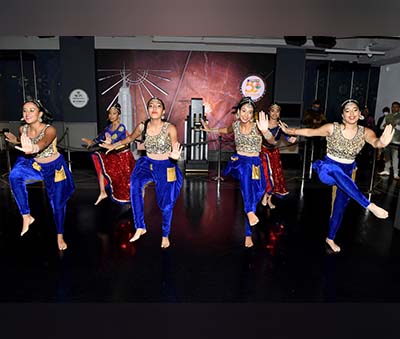 FIA Chairman Ankur Vaidya, President Elect Kenny Desai, Past President Alok Kumar and Executive members Parveen Bansal and Saurin Parikh participated in the event as well. In follow up to a spectacular dance performance by the students of Aum Dance Creations the Empire State Building ceremonial lighting was turned on together by Jay Sean, Thara Natalie and Hon. Consul General Jaiswal. H.E. Randhir Jaiswal conveyed Diwali wishes and thanked the American community for accepting and embracing diversity.
FIA Chairman Ankur Vaidya, President Elect Kenny Desai, Past President Alok Kumar and Executive members Parveen Bansal and Saurin Parikh participated in the event as well. In follow up to a spectacular dance performance by the students of Aum Dance Creations the Empire State Building ceremonial lighting was turned on together by Jay Sean, Thara Natalie and Hon. Consul General Jaiswal. H.E. Randhir Jaiswal conveyed Diwali wishes and thanked the American community for accepting and embracing diversity. The FIA believes that such gestures by ESRT help in spreading the ancient Indian philosophy of ‘Vasudeva Kutumbakam’ (the world is one family) and also demonstrates a great harmony in spirit and deeds between people of the world’s largest and oldest democracies, the organization stated in a press release. Despite the challenges and changes due to the Covid-19 pandemic, FIA has not deterred from its goal of serving the community, it said.
The FIA believes that such gestures by ESRT help in spreading the ancient Indian philosophy of ‘Vasudeva Kutumbakam’ (the world is one family) and also demonstrates a great harmony in spirit and deeds between people of the world’s largest and oldest democracies, the organization stated in a press release. Despite the challenges and changes due to the Covid-19 pandemic, FIA has not deterred from its goal of serving the community, it said. “To those who celebrate here in America, we are grateful to you for making the traditions of Diwali part of America’s story. For generations, you have opened your homes and hearts during Diwali to exchange gifts and sweets, host feasts with family and friends, and organize cultural programs in our communities – with prayers and dances, vibrant and colorful art, and sparklers and fireworks – that bring us all together.
“To those who celebrate here in America, we are grateful to you for making the traditions of Diwali part of America’s story. For generations, you have opened your homes and hearts during Diwali to exchange gifts and sweets, host feasts with family and friends, and organize cultural programs in our communities – with prayers and dances, vibrant and colorful art, and sparklers and fireworks – that bring us all together.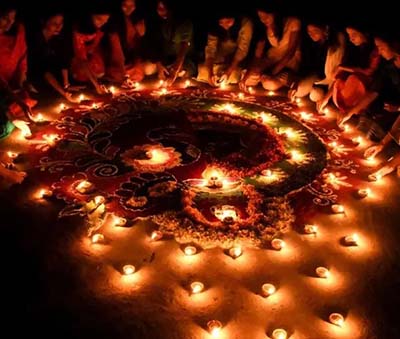 Congresswoman Carolyn B. Maloney, D-NY, chairwoman of the Committee on Oversight and Reform, joined on Nov. 3, 2021, with Congressmen Raja Krishnamoorthi, D-IL, and Gregory Meeks, D-NY, chair of the House Foreign Affairs Committee, and New York, as well as national advocates to announce the introduction of the Deepavali Day Act. This legislation would make Diwali a nationally recognized federal holiday.
Congresswoman Carolyn B. Maloney, D-NY, chairwoman of the Committee on Oversight and Reform, joined on Nov. 3, 2021, with Congressmen Raja Krishnamoorthi, D-IL, and Gregory Meeks, D-NY, chair of the House Foreign Affairs Committee, and New York, as well as national advocates to announce the introduction of the Deepavali Day Act. This legislation would make Diwali a nationally recognized federal holiday. The events included deepmala as well as katha and kirtan by Bhai Rajinder Singh and Jatha, Bhai Parminderjit Singh and bhai Inderjit Singh Khalsa.
The events included deepmala as well as katha and kirtan by Bhai Rajinder Singh and Jatha, Bhai Parminderjit Singh and bhai Inderjit Singh Khalsa. Sikh Religious Society, a non-profit organization, in Palatine, Illinois was formed in 1974 and its first formal Prakash Divas (the ceremonial acceptance of Guru GRANTH Sahib {Sikh’s holy scripture/book} at this new place of worship was celebrated in 1975. The organization focuses on Sikh religious services, Punjabi language/ Kirtan classes. Another focus of this society is on the community service, charity and other Non Profit endeavors to promote the Punjabi culture and heritage.
Sikh Religious Society, a non-profit organization, in Palatine, Illinois was formed in 1974 and its first formal Prakash Divas (the ceremonial acceptance of Guru GRANTH Sahib {Sikh’s holy scripture/book} at this new place of worship was celebrated in 1975. The organization focuses on Sikh religious services, Punjabi language/ Kirtan classes. Another focus of this society is on the community service, charity and other Non Profit endeavors to promote the Punjabi culture and heritage.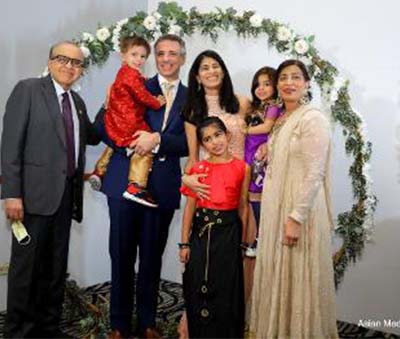 Another board member Nand Balani elaborated on the initiative called, Alliance of Global Sindhi Association that connects Sindhis all over to the world. The three aims of the alliance focus on matrimonial services, romanized script for sindhi language, and a global sindhi directory.
Another board member Nand Balani elaborated on the initiative called, Alliance of Global Sindhi Association that connects Sindhis all over to the world. The three aims of the alliance focus on matrimonial services, romanized script for sindhi language, and a global sindhi directory.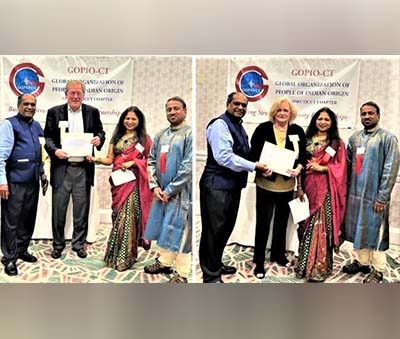 Future 5 helps underprivileged students in the Stamford High School system. Future 5 envisions a world where all students can be part of a vibrant and supportive community and access the people and resources they need for college, career and life success.
Future 5 helps underprivileged students in the Stamford High School system. Future 5 envisions a world where all students can be part of a vibrant and supportive community and access the people and resources they need for college, career and life success. The event was attended in-person by several dignitaries, including United States Sen. Charles E. Schumer, U.S. Rep. Carolyn Maloney, India’s Consul General in New York Randhir Jaiswal, New York State Sen. John Liu, Padma Shri Sudhir Parikh, chairman of Parikh Worldwide Media and ITV Gold, H.R. Shah of TV Asia, representatives of the Indian Police Officers Society from the New York Police Department, and several other special guests who spoke on stage about the meaning of Diwali and the joy of celebrating it after Covid.
The event was attended in-person by several dignitaries, including United States Sen. Charles E. Schumer, U.S. Rep. Carolyn Maloney, India’s Consul General in New York Randhir Jaiswal, New York State Sen. John Liu, Padma Shri Sudhir Parikh, chairman of Parikh Worldwide Media and ITV Gold, H.R. Shah of TV Asia, representatives of the Indian Police Officers Society from the New York Police Department, and several other special guests who spoke on stage about the meaning of Diwali and the joy of celebrating it after Covid. This year in contrast to last year, Liu said, the number of Diwali celebrations has risen, “in our schools, in our mandirs, and City Hall,” he said, a tradition he started when he was a New York City Councilor. “There’s no better place to celebrate Diwali than at the ‘Crossroads of the World’, right here in Times Square, New York City. Because this is such an important holiday for billions of people around the world symbolizing the victory of good over evil, light over darkness …”
This year in contrast to last year, Liu said, the number of Diwali celebrations has risen, “in our schools, in our mandirs, and City Hall,” he said, a tradition he started when he was a New York City Councilor. “There’s no better place to celebrate Diwali than at the ‘Crossroads of the World’, right here in Times Square, New York City. Because this is such an important holiday for billions of people around the world symbolizing the victory of good over evil, light over darkness …”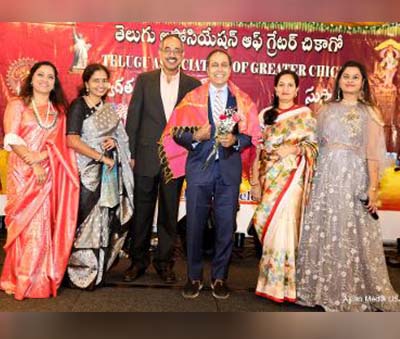 The event was described as a grand success with an overwhelming response from the Telugu community with 2000+ guests in attendance over 2 days. Multiple guests from Community, National and Local Telugu organizations, long time Sponsors PMSI Ashok Lakshmanan, NYLife Krishna Rangaraju joined along with Chief Guest U.S Congressman Raja Krishnamoorthy, Dr. Sreenivas Reddy, a member of the National council on White House History and Indian Consulate General’s office represented by Consul Gopal Bhagath.
The event was described as a grand success with an overwhelming response from the Telugu community with 2000+ guests in attendance over 2 days. Multiple guests from Community, National and Local Telugu organizations, long time Sponsors PMSI Ashok Lakshmanan, NYLife Krishna Rangaraju joined along with Chief Guest U.S Congressman Raja Krishnamoorthy, Dr. Sreenivas Reddy, a member of the National council on White House History and Indian Consulate General’s office represented by Consul Gopal Bhagath. As part of the 50th year celebrations second day “Joruga Husharuga – Dasara and Diwali celebrations”, 250+ participants including kids, youth, couples and senior members of TAGC entertained guests with their performances. Event brought a true festive atmosphere where all the seniors, youth and kids came together under one roof to celebrate the 50-year history of the Telugu community in America and the importance of perseverance.
As part of the 50th year celebrations second day “Joruga Husharuga – Dasara and Diwali celebrations”, 250+ participants including kids, youth, couples and senior members of TAGC entertained guests with their performances. Event brought a true festive atmosphere where all the seniors, youth and kids came together under one roof to celebrate the 50-year history of the Telugu community in America and the importance of perseverance. “But one of the things that concern me most about the last few years is another type of pandemic, the invisible pandemic that we are in the midst of. That’s a pandemic of polarization where it feels increasingly people have turned against each other, where they have demonized one another, called each other evil and treated each other as so. That’s a particular kind of darkness,” he said.
“But one of the things that concern me most about the last few years is another type of pandemic, the invisible pandemic that we are in the midst of. That’s a pandemic of polarization where it feels increasingly people have turned against each other, where they have demonized one another, called each other evil and treated each other as so. That’s a particular kind of darkness,” he said. The event was attended by Congressmen Raja Krishnamoorthy, Illinois; Tim Ryan, Ohio; Greg Stanton, Arizona; Danny Davis, Illinois; Mike Quigley, Illinois; and, Audrey Kitawaga, Ambassador of Religions for Peace. Ambassador Sandhu emphasized critical points regarding the element of solidarity, the unity and partnership between the two nations, the importance of science and spiritual and extending happiness and kindness to all in these unprecedented times.
The event was attended by Congressmen Raja Krishnamoorthy, Illinois; Tim Ryan, Ohio; Greg Stanton, Arizona; Danny Davis, Illinois; Mike Quigley, Illinois; and, Audrey Kitawaga, Ambassador of Religions for Peace. Ambassador Sandhu emphasized critical points regarding the element of solidarity, the unity and partnership between the two nations, the importance of science and spiritual and extending happiness and kindness to all in these unprecedented times. The event was attended by Media Houses, Performers and the Sponsors of Diwali at Times Square. The program started with Ganesh Pooja followed by Diya Lighting Ceremony and Presentation by Neeta Bhasin, Founder of Diwali at Times Square where she shared the details of the upcoming festival. Sponsors like Shoprite and American Airlines spoke of the significance and importance of cultural event as big as Diwali at Times Square and its impact on the community.
The event was attended by Media Houses, Performers and the Sponsors of Diwali at Times Square. The program started with Ganesh Pooja followed by Diya Lighting Ceremony and Presentation by Neeta Bhasin, Founder of Diwali at Times Square where she shared the details of the upcoming festival. Sponsors like Shoprite and American Airlines spoke of the significance and importance of cultural event as big as Diwali at Times Square and its impact on the community. The two leaders discussed with Pope Francis issues covering a range of areas of interest, including COVID-19, general global perspectives and maintaining peace and tranquility. After the meeting, Modi tweeted, with pictures of him embracing the Pope, “Had a very warm meeting with Pope Francis. I had the opportunity to discuss a wide range of issues with him and also invited him to visit India.”
The two leaders discussed with Pope Francis issues covering a range of areas of interest, including COVID-19, general global perspectives and maintaining peace and tranquility. After the meeting, Modi tweeted, with pictures of him embracing the Pope, “Had a very warm meeting with Pope Francis. I had the opportunity to discuss a wide range of issues with him and also invited him to visit India.” Pope Francis and the Prime Minister then exchanged gifts. Modi gave the Pope a silver candlestick and a copy of The Climate Climb. Pope Francis gave Modi a bronze plaque with the inscription “the desert will become a garden,” and copies of the pope’s writings, including his encyclicals “Laudato Si’” and “Fratelli Tutti,” as well as the “
Pope Francis and the Prime Minister then exchanged gifts. Modi gave the Pope a silver candlestick and a copy of The Climate Climb. Pope Francis gave Modi a bronze plaque with the inscription “the desert will become a garden,” and copies of the pope’s writings, including his encyclicals “Laudato Si’” and “Fratelli Tutti,” as well as the “ “The meeting should not be seen merely as the one between two country heads, rather it was the head of the largest democracy and an ancient culture of the world meeting the head of the largest religious community in the world. This brings in hope for enhancing human fraternity and caring for the poor, because that’s what Christianity stands for. It would bring in positive efforts in India for a mutual trust and collaboration between people of different religious groups. It would also contribute to the very need for dialogues. We are very delighted that the Prime Minister has opened ways for a Papal visit to India,” the Cardinal Cleemis told the media.
“The meeting should not be seen merely as the one between two country heads, rather it was the head of the largest democracy and an ancient culture of the world meeting the head of the largest religious community in the world. This brings in hope for enhancing human fraternity and caring for the poor, because that’s what Christianity stands for. It would bring in positive efforts in India for a mutual trust and collaboration between people of different religious groups. It would also contribute to the very need for dialogues. We are very delighted that the Prime Minister has opened ways for a Papal visit to India,” the Cardinal Cleemis told the media. The Covid pandemic has impacted all aspects of human life as never been before. The past two years have been challenging to everyone, particularly those are assigned with the responsibility of caring for the sick, especially as hundreds of Millions were affected by the big pandemic. Over 115,000 health care workers died from Covid-19 from January 2020 to May of this year, according to a new World Health Organization estimate.
The Covid pandemic has impacted all aspects of human life as never been before. The past two years have been challenging to everyone, particularly those are assigned with the responsibility of caring for the sick, especially as hundreds of Millions were affected by the big pandemic. Over 115,000 health care workers died from Covid-19 from January 2020 to May of this year, according to a new World Health Organization estimate. Accordingly, some of the major themes at the convention include: Yoga and Meditation practices, Welcome kit with books & self-care supplies, A Personal Reflexology Session, Take home wellness routine, Ailment based yoga therapy sessions, Workshop on Spiritual well-being, Book talk with Yoga Gurus, including on the science of Yoga & Lifestyle medicine, as well as an unique opportunity to visit first of its kind in San Antonio, Aum Ashram as part of the Wellness session.
Accordingly, some of the major themes at the convention include: Yoga and Meditation practices, Welcome kit with books & self-care supplies, A Personal Reflexology Session, Take home wellness routine, Ailment based yoga therapy sessions, Workshop on Spiritual well-being, Book talk with Yoga Gurus, including on the science of Yoga & Lifestyle medicine, as well as an unique opportunity to visit first of its kind in San Antonio, Aum Ashram as part of the Wellness session. The event was organized by Manoj Rathod and Tanmay Patel featured two very well-known versatile vocalists Badal Parmar and Bharti Desai who kept the atmosphere upbeat and devotional and had everyone dancing throughout the entire event. Badal Parmar performed traditional Kathiawadi style garba as well as popular Hindi songs. His style of performance reflects an immense amount of Gujarati garba as well as modern beats. This unique style of singing is what makes him such a versatile performer. Garba Queen of United State of America Desai who is an award-winning singer in Chicago enthralled the audience with her charming personality. She continued amazing Garbas in Two Taali. In Raas everybody enjoyed Disco Dandia, Sanedo, Amu Kaka Bapa Na, Bhai-Bhai, Hitch..
The event was organized by Manoj Rathod and Tanmay Patel featured two very well-known versatile vocalists Badal Parmar and Bharti Desai who kept the atmosphere upbeat and devotional and had everyone dancing throughout the entire event. Badal Parmar performed traditional Kathiawadi style garba as well as popular Hindi songs. His style of performance reflects an immense amount of Gujarati garba as well as modern beats. This unique style of singing is what makes him such a versatile performer. Garba Queen of United State of America Desai who is an award-winning singer in Chicago enthralled the audience with her charming personality. She continued amazing Garbas in Two Taali. In Raas everybody enjoyed Disco Dandia, Sanedo, Amu Kaka Bapa Na, Bhai-Bhai, Hitch.. “Navaratri Garba is very special as it honors Shakti in very rhythmic ways. We all love the whole atmosphere of colors, the clothes and of course, the music and then there is always the fun of dressing traditionally. Western dresses are replaced by Lengha-Choli, matching jewelry and foot wear”, said one of the participants. The evening was followed by traditional garba music and concluded in the wee hours of morning highlighted by devotional Arti of Mataji.
“Navaratri Garba is very special as it honors Shakti in very rhythmic ways. We all love the whole atmosphere of colors, the clothes and of course, the music and then there is always the fun of dressing traditionally. Western dresses are replaced by Lengha-Choli, matching jewelry and foot wear”, said one of the participants. The evening was followed by traditional garba music and concluded in the wee hours of morning highlighted by devotional Arti of Mataji. Whistleblower Frances Haugen, a former Facebook product manager, has exposed the company’s
Whistleblower Frances Haugen, a former Facebook product manager, has exposed the company’s  Building on earlier work with Tiffany Ford from May 2020, “
Building on earlier work with Tiffany Ford from May 2020, “ The show commenced with the Lamp Lighting ceremony by the MAFS Board Members, President Dr. Firdaus Jafri, Vice-President Mr. Nikunj Baxi, Secretary Dr. Rakesh Asthana, Treasurer Sagar Kumar, Board members James D’Mello, Dr. Sonal Patel, Vasanti Bhatt, Monali Desai and the Founder/Executive Director, Dr. Mrs Santosh Kumar.
The show commenced with the Lamp Lighting ceremony by the MAFS Board Members, President Dr. Firdaus Jafri, Vice-President Mr. Nikunj Baxi, Secretary Dr. Rakesh Asthana, Treasurer Sagar Kumar, Board members James D’Mello, Dr. Sonal Patel, Vasanti Bhatt, Monali Desai and the Founder/Executive Director, Dr. Mrs Santosh Kumar. A special shout out to the dancers from the Tarana Dance Academy and the Saloni group. The experienced dancers were well coordinated with precise choreography which helped them receive a loud roar of applause from the audience. Their choice of costume was so apt.
A special shout out to the dancers from the Tarana Dance Academy and the Saloni group. The experienced dancers were well coordinated with precise choreography which helped them receive a loud roar of applause from the audience. Their choice of costume was so apt. In addition to three days of Puja and all its special features, they also had an array of cultural programs with some legendary artists from both the USA as well as from India. Last two years, BAGC through its strong tech committee has continued connecting with the community virtually due to the challenges posed by Covid-19 Pandemic through BAGC Live YouTube channel and BAGC Radio in showcasing its virtual events to the entire community across the globe.
In addition to three days of Puja and all its special features, they also had an array of cultural programs with some legendary artists from both the USA as well as from India. Last two years, BAGC through its strong tech committee has continued connecting with the community virtually due to the challenges posed by Covid-19 Pandemic through BAGC Live YouTube channel and BAGC Radio in showcasing its virtual events to the entire community across the globe. ‘To New India with Love’ is a non-commercial venture, and examines the subject of youth aspirations. The screenplay and dialogues are written by Murtaza Ali Khan and Rakesh Zharotia is the film’s editor and assistant director. While starting the proceedings for the day, Indu Jaiswal, Chairperson, Indian American Forum introduced the moderators and the panelists while welcoming the guests and underlining the agenda of the event. She congratulated Trilok Malik on the success of ‘To New India with Love’ which has been praised worldwide by audience and critics alike for his inspiring and empowering message to the youth of India.
‘To New India with Love’ is a non-commercial venture, and examines the subject of youth aspirations. The screenplay and dialogues are written by Murtaza Ali Khan and Rakesh Zharotia is the film’s editor and assistant director. While starting the proceedings for the day, Indu Jaiswal, Chairperson, Indian American Forum introduced the moderators and the panelists while welcoming the guests and underlining the agenda of the event. She congratulated Trilok Malik on the success of ‘To New India with Love’ which has been praised worldwide by audience and critics alike for his inspiring and empowering message to the youth of India. What makes this a historic moment is the fact that, he is the first Indian American who rose from a foot-soldier level to this distinctive honor, whose sole focus and establishment is not United States (U.S.) but rural India. Rameshbhai, as he is popularly known, has been a founder member of ‘Ekal-USA’ and credited with building a modest ‘one-teacher-school’ project, 32 years back into a national brand in U.S. for ‘selfless social work’, with over 60 widespread chapters in U.S., Canada and beyond. While endorsing his successor, Bagraji – a highly admired visionary possessing leadership acumen – expressed nothing but confidence and admiration for the new CEO. In a statement he said,” Rameshbhai will improve upon working of Ekal in fields of operational efficiency and organizational growth. He was my guide and supporter for all matters related to foreign chapters. Moreover, his we unmatched passion and long experience in serving the community in multiple sectors, including VHP & Ekal, has always been a great asset”. Dr Mahesh Mehta, former Chairman of ‘VHP of America’ commenting on Ekal’s trailblazing success across the continent, communicated that,” I am excited and proud that Rameshbhai fulfilled the task he was entrusted with in such a monumental way.”
What makes this a historic moment is the fact that, he is the first Indian American who rose from a foot-soldier level to this distinctive honor, whose sole focus and establishment is not United States (U.S.) but rural India. Rameshbhai, as he is popularly known, has been a founder member of ‘Ekal-USA’ and credited with building a modest ‘one-teacher-school’ project, 32 years back into a national brand in U.S. for ‘selfless social work’, with over 60 widespread chapters in U.S., Canada and beyond. While endorsing his successor, Bagraji – a highly admired visionary possessing leadership acumen – expressed nothing but confidence and admiration for the new CEO. In a statement he said,” Rameshbhai will improve upon working of Ekal in fields of operational efficiency and organizational growth. He was my guide and supporter for all matters related to foreign chapters. Moreover, his we unmatched passion and long experience in serving the community in multiple sectors, including VHP & Ekal, has always been a great asset”. Dr Mahesh Mehta, former Chairman of ‘VHP of America’ commenting on Ekal’s trailblazing success across the continent, communicated that,” I am excited and proud that Rameshbhai fulfilled the task he was entrusted with in such a monumental way.” In the initial days of ‘Ekal’ he used to carry box-load of self-prepared information-publicity material to various community events in the hope of getting an opportunity to talk about rural illiteracy. With amicable nature and deep convictions assisting his hard-work, he soon found access wherever he went. Over the years, Rameshbhai, with his dedication and tenacity has brought in numerous donors, volunteers and thinkers to Ekal fold and motivated diverse groups to join hands with Ekal. Besides Ekal, he is responsible for establishing ‘Gujarati Samaj of Houston’ and spearheading countless projects related to ‘eyecare’ in India. During this entire community-centric journey, he was assisted by his soulmate, wife-Kokilaben. They both have been felicitated number of times by the Indian diaspora in U.S.
In the initial days of ‘Ekal’ he used to carry box-load of self-prepared information-publicity material to various community events in the hope of getting an opportunity to talk about rural illiteracy. With amicable nature and deep convictions assisting his hard-work, he soon found access wherever he went. Over the years, Rameshbhai, with his dedication and tenacity has brought in numerous donors, volunteers and thinkers to Ekal fold and motivated diverse groups to join hands with Ekal. Besides Ekal, he is responsible for establishing ‘Gujarati Samaj of Houston’ and spearheading countless projects related to ‘eyecare’ in India. During this entire community-centric journey, he was assisted by his soulmate, wife-Kokilaben. They both have been felicitated number of times by the Indian diaspora in U.S. Torrential rain has battered the coastal state of Kerala last week, causing rivers to swell and flooding roads that left vehicles submerged in muddy waters, with some houses reduced to rubble.
Torrential rain has battered the coastal state of Kerala last week, causing rivers to swell and flooding roads that left vehicles submerged in muddy waters, with some houses reduced to rubble. In this context, as part of an ongoing awareness and education campaign about high risk heart disease in South Asians, American Association of Physicians of Indian Origin (AAPI) the largest ethnic medical organization in the United States presented two eminent speakers and experts, Dr. Enas Enas and Dr. Amit Kera, discussing ways to create awareness on Heart Disease Among South Asians during a webinar on Saturday, October 16th, 2021.
In this context, as part of an ongoing awareness and education campaign about high risk heart disease in South Asians, American Association of Physicians of Indian Origin (AAPI) the largest ethnic medical organization in the United States presented two eminent speakers and experts, Dr. Enas Enas and Dr. Amit Kera, discussing ways to create awareness on Heart Disease Among South Asians during a webinar on Saturday, October 16th, 2021. Dr. Enas referred to several research/studies around the world, showing high prevalence of CAD among Indians. “Indians have a big problem with premature heart disease,” Dr. Enas said and pointed out that 185,000 people of South Asian origin die of heart disease per year as against 15,000 Whites die of the same health issue. While referring to Mitigating Risk Factors, Dr. Enas recommended Indians to follow the American Heart Association developed Life Simple 7 with additional requirement for exercise and maintaining sugar level below 140.
Dr. Enas referred to several research/studies around the world, showing high prevalence of CAD among Indians. “Indians have a big problem with premature heart disease,” Dr. Enas said and pointed out that 185,000 people of South Asian origin die of heart disease per year as against 15,000 Whites die of the same health issue. While referring to Mitigating Risk Factors, Dr. Enas recommended Indians to follow the American Heart Association developed Life Simple 7 with additional requirement for exercise and maintaining sugar level below 140. Dr. Amit Kera, a new rising star in Preventive Cardiology, built on that argument and presented genomic data to fill the gap and also pointed out that usual risk scoring has been done on Caucasians and cannot be extrapolated to south Asians. He advocated for the need for our own data base and especially genomic data to go beyond coronary calcium score and use “ Polygenic score,” which can predict even more accurately the risk of heart disease individually what he calls “Precision Medicine,” a futuristic concept, which he is working on as Associate Director at prestigious Broad institute affiliated with MIT and Harvard. Pointing to international studies that point to prevalence of Cardiovascular diseases high among South Asians, he said, Diabetes is diagnosed four times more among the Asians in comparison with Europeans.
Dr. Amit Kera, a new rising star in Preventive Cardiology, built on that argument and presented genomic data to fill the gap and also pointed out that usual risk scoring has been done on Caucasians and cannot be extrapolated to south Asians. He advocated for the need for our own data base and especially genomic data to go beyond coronary calcium score and use “ Polygenic score,” which can predict even more accurately the risk of heart disease individually what he calls “Precision Medicine,” a futuristic concept, which he is working on as Associate Director at prestigious Broad institute affiliated with MIT and Harvard. Pointing to international studies that point to prevalence of Cardiovascular diseases high among South Asians, he said, Diabetes is diagnosed four times more among the Asians in comparison with Europeans. Describing Domestic Violence as “a serious public health concern” Dr. Anupama Gotimukula, President of AAPI, in her welcome address said, “October is Domestic Awareness Month. Nearly one in four women and one in seven men in the U.S. have experienced physical violence at the hands of their domestic partners, according to the U.S. Centers for Disease Control and Prevention. The very important discussion today with an experts panel is aimed at helping AAPI members and the larger society to learn on ways to help promote healthy, respectful and nonviolent relationships.”
Describing Domestic Violence as “a serious public health concern” Dr. Anupama Gotimukula, President of AAPI, in her welcome address said, “October is Domestic Awareness Month. Nearly one in four women and one in seven men in the U.S. have experienced physical violence at the hands of their domestic partners, according to the U.S. Centers for Disease Control and Prevention. The very important discussion today with an experts panel is aimed at helping AAPI members and the larger society to learn on ways to help promote healthy, respectful and nonviolent relationships.” Dr. Preeti Saran, Domestic Violence Survivor and currently practicing Family Medicine & Obesity Specialist at RNJ Barnabas Hospital, New Jersey, pointed out that Domestic Violence is prevalent in all parts of the world. Sharing her own life’s challenges and abuses, Dr. Saran said, “Coming from very traditional society back in India, initially I thought it was happening to me because of my background.” Married to a dominant person, who was demanding, but suspicious and with trust issues, she had suffered immensely with insecurity and complexities of married life with intimidation and fearful for her own life. But she was able to turn her life around and has made a positive impact in the society. “Now, I am to reach out to other women who need support,” she said.
Dr. Preeti Saran, Domestic Violence Survivor and currently practicing Family Medicine & Obesity Specialist at RNJ Barnabas Hospital, New Jersey, pointed out that Domestic Violence is prevalent in all parts of the world. Sharing her own life’s challenges and abuses, Dr. Saran said, “Coming from very traditional society back in India, initially I thought it was happening to me because of my background.” Married to a dominant person, who was demanding, but suspicious and with trust issues, she had suffered immensely with insecurity and complexities of married life with intimidation and fearful for her own life. But she was able to turn her life around and has made a positive impact in the society. “Now, I am to reach out to other women who need support,” she said. The COVID-19 vaccine made by
The COVID-19 vaccine made by